#sacred realm analysis
Text
Sacred Realm updated which means im actually so excited to be making this omg
Hi there Sacred Realm fans! :D
It is I, the one who makes the analysis posts on various comics on the internet. (With permission course) Because I love doing them and they bring me joy.
If you are unaware of what Sacred Realm is, it's a Legend of Zelda AU about a new Link who gets a little medallion that makes him a badass, also it can hold the spirits of heroes from across the realms (Including my fave boy ever okay)
Before I begin, I'll get the important stuff done, This is done with permission from @zelda-the-sacred-realm, and all art from the comics belongs to the comic artist. Please do me a favour and go and check it out because it's a wonderful comic and extremely well-drawn and written.
Now, grab some popcorn, and a drink and please enjoy me rambling about a comic that I enjoy so much. :D
Lets begin!
First, some sass

Damn, possessed Link got a mouth on him. Low key I love him, he looks like he could go for round two like right now. Wouldn't be surprised if he went for the hero of time next.
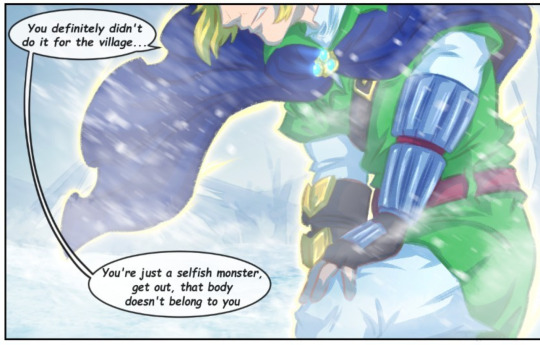
My eyebrows shot up at this.
Time KNOW's
let me repeat that
TIME KNOWS. HE KNOWS WHATEVER IS IN THE MEDALLION CAUSING THIS.
(More on this later)
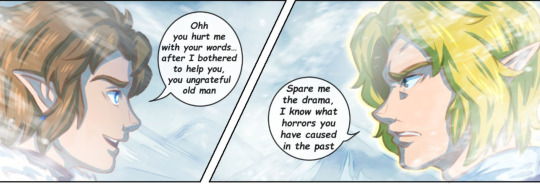
He knows he knows he knows he knows he knows
I can hear the mocking voice of Link while he is saying this. Time has experience with this particular entity before.

Okay, so here is when it gets interesting.
Possessed Link or this entity I suppose, referring to Time and in turn Hylians as 'Your Race' Tells me a couple of things.
This thing in the medallion isn't a Hylian spirit. So as much and as fun as a dark link theory is, I dont think it could be.
Time arguing that we're not perfect, again referring to Hylians sounds very much like an "I'm speaking with a god speech"
I present my theory on what is in the medallion.
An extra spirit, a god of some description, from the spirit realm. Out to get revenge on Hylians.

Time has been to the spirit realm, in his games. (I am under the assumption that those still occur in this canon please do correct me if I'm wrong here.)
I'm convinced that this thing in the medallion is a deity of some kind because of the eye colour. I can't get over it.
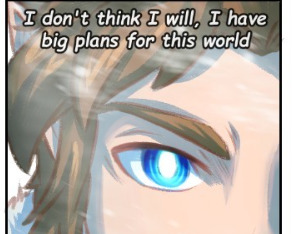
This style of blue, with no pupils.
We've seen it before.
On Hylia.
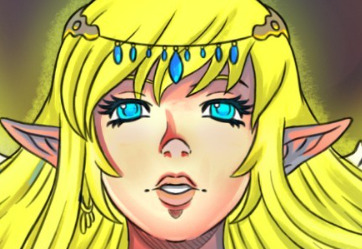
From Chapter 2 fate PT2
And here is the first time we see it on Link for comparison, With Sky's alongside him for comparison for what Hylian eyes look like.

From Chapter 2 Fate PT3
The colour isn't exact so it can't be Hylia herself I dont think, but, i believe that there is a spirit trying to escape the sacred realm and is using Link to do it.
Okay, enough of my conspiracy theories moving on!
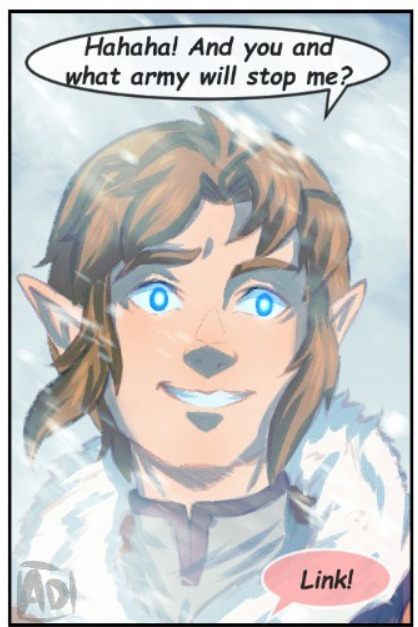
Link you gotta wake up!
Sky thinks so, I love the coloured speech bubble, what a good idea.
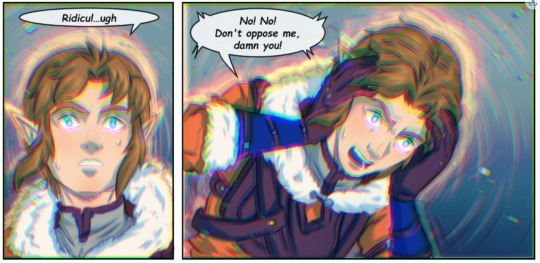
OH BOY I LOVE THESE PANELS
You know those scenes in video games when you're fighting off something that's trying to possess you and you have that ominous-sounding echo that seems to reverberate through your head. But is also muffled at the same time?
(If I find a game example I'll link it)
This. Put that noise you think off over this.
KICK ITS BUTT LINK GET IT, GET BACK IN HERE.
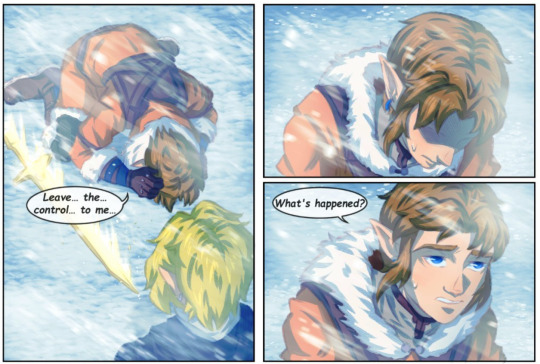
These five panels tell so much when it comes to how much effort Link has to go through to fight off the medallion possession. I wonder if its going to be easier or harder for him to fight it off as he gains spirits in the medallion.
You can really feel his struggle and I just love it. The visual storytelling is incredible in this comic and I will fan girl about it all day because I just love it so much

I'm thinking he says this to gauge just how bad this possession is. time seems like the guy who would, especially as he already seems to know what this is.
I wonder if he really is the hero of realms?
Yes, Time. Yes, he is.
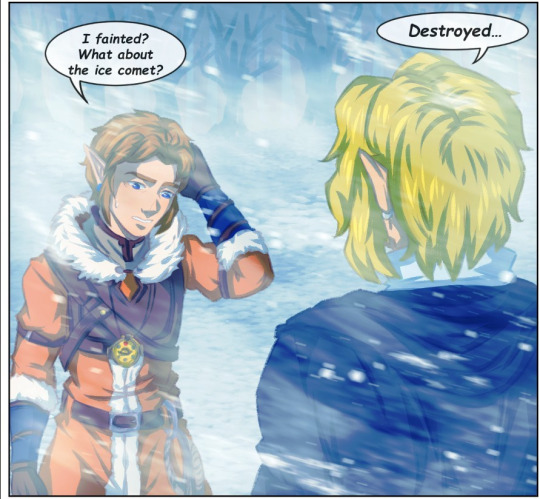
The face he dosent remember any time he's possessed by the medallion is a little worrying.
Makes me think that could be used later.
Like, Link dosent remember fighting this ice comet now. What if he fights an enemy while possessed, breaks the possession then has to relearn how to defeat it because as possessed link he's not gained any information.
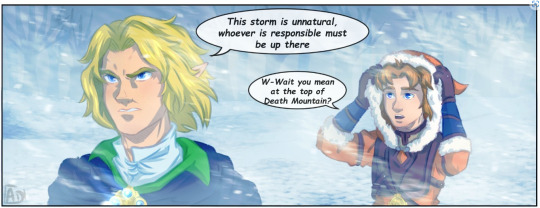
Man Link is a cinnamon roll sometimes and I love him dearly okay.
Alrighty, thats me finished with my rambling. Thank you so much for sticking with me through this! And thanks again to @zelda-the-sacred-realm for the permission to do these i really appreciate it.
Please please go and check out the rest of the comic if you haven't it's amazing :D
Thats me finished for this chapter, so I'll be headed out!
Hope you have a wonderful day! :D
#comic analysis with major#ramble corner with major#zelda sacred realm#zeldathesacredrealm#sacred realm#loz sr#sr realms#sr time#sr sky#me gushing over the art for ages like#my g its so amazing#i love this comic#im so happy i get to make these for this one too#Writing these brings me almost as much joy as Sky does#And that's saying something#because in every iteration dear god does he bring me joy#Anyway#Link gets possessed by a god in the medallion theory 101#yall cant stop my agenda#im kidding#ztsr#hero of time#hero of sky#hero of realms#i dont think there are any tags i forgot#:D#i hope you enjoyed!#sacred realm analysis
63 notes
·
View notes
Text
Overanalyzing 4KOTA Chapter 142 instead of just waiting for more info (1/2?)
Honestly? I'm writing King's side of this separately, because it's about time I started talking about him here l and I know I can go on forever about him. That field of over-analysis needs its own house. I would go off about him first but then I'd forget his kids entirely and I don't want to do that to them...
Speaking of--

So silly. So precious. Berte is so Helbram-coded and I'm sure that's intentional resemblance.
You know...I wonder which of their traits were inherited from Diane's parents. Probably the golden hair on almost half of them at least. Sixtus and Tioreh's pink hair looks more like a genetic mutation...unless their hair color is inherited from the leaf color of the Sacred Tree? That's possible too.
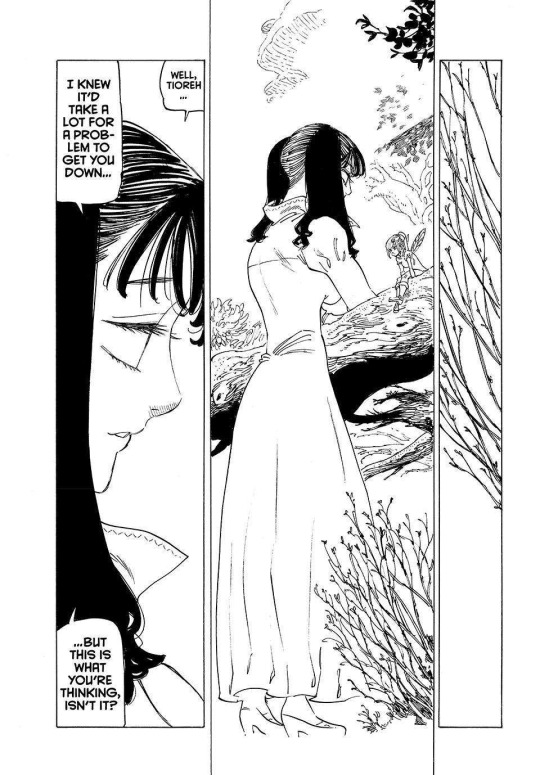
Diane seems less energetic since becoming a mother. She's settled down and has been shown to be gentle more often than bubbly, which was the impression she gave me in the original series. I'm assuming she hasn't fought since entering the Fairy Realm, too. She's put the stress of the Holy War behind her, and I'm happy that she seems content with her lots of babies. I wonder if she'll get to hear about Dolores once the current issues are over. I'm sure hearing she's Nasiens's adoptive big sister will be a shock. Diane deserves to know that.

The way Tioreh says this makes me suspect Puck is the one behind Nasiens and Myrtel's switcheroo. He must really love that "prank" in that case. Regardless of who was behind it, though, that's actually fucked up. A fairy trolled their own king by swapping their first child with a human, probably knowing exactly what issues both kids would be put in. I can't call this just a prank. I love King to death, but his people are their own kind of awful...

For this moment, let's glance back at how she reacted to that news at first.
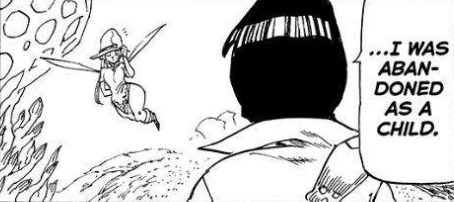
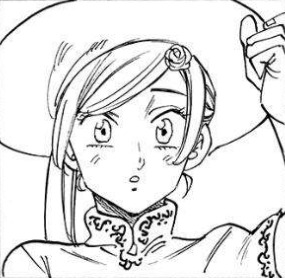
Tioreh must have been suspecting this the whole time Nasiens was here, but this reveal may be the moment she started to seriously believe it, if not when Nasiens admitted to feeling healthier in the Fairy Realm. After this, she started to open up about her siblings more and telling Nasiens that he's like them--especially like Phao. All of this is stuff that Nasiens didn't know about since he met her two years ago. All of the tension in this family over Nasiens and Myrtel has been building up for so long...and right now we're watching it all cave in. I'm sure King and Diane had good intentions for hiding the truth, but hiding it's not working anymore.
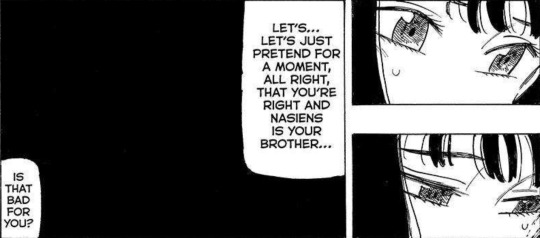
And Diane knows it's not working anymore. I'm stuck on her asking "Is that bad for you?" Why is she asking that of all things? Is that what King and Diane were so worried about when they decided to never come out about this? Did they think their kids would be upset with having a human for an older brother?
Okay, but maybe that's not all that they considered. Maybe they got worried about how their people outside of their family would react to their theories being confirmed. If that happened, as unfortunate as it is, Mertyl would probably get more ostracized than he was. With that in mind, I'm sure his parents made that choice to protect him from some of the problems he'd inevitably go through. It's a nice thought that way, but this was still a bad call. They made too many assumptions of their own kids' feelings.

In other news...Phao was lurking... Now they're all gonna know and clear up this misunderstanding with their parents, right?
Anyway, I feel like I've written too much for one post, so I'll go on about the rest of the chapter tomorrow. Closing this part with this:

myrtel peek
58 notes
·
View notes
Text
Papa Emeritus III: The analysis of mythological references
Here are my thoughts of Terzo as a character, finally translated to English. Thank you to @osirisiii-bc who is so kind and gracious!
Read on AO3

Note: The author strongly recommends you to check out the Third Era's "policy document" - The Prologue and Introduction by Peter Bebergal before reading this article. This promotional material was sent out to the media by the label on the occasion of the Meliora release.

This analysis is based on the Prologue to Meliora written by Peter Bebergal. At first glance, this text may seem like a set of nonconnected paragraphs, as well as the music video "From the Pinnacle to the Pit" can be considered as a simple cutting of scenes from old movies. But together these two materials can shed light on the mythology of the Meliora Era and the story of Papa Emeritus III - his origin, background and motives. Let's try to understand how it happened that in the image of Papa combined three mythological characters: Prometheus, Icarus and Lucifer.
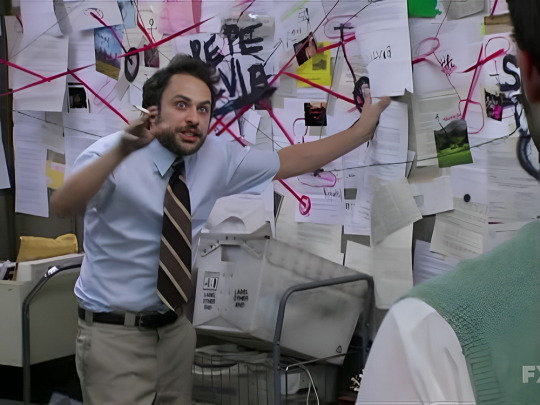
This is what the author of this analysis looked like when she wrote it
First, let's take a superficial look at the plot. The action of the video takes place in a fictional retrofuturistic city decorated in Art Deco style. The Prologue even gives us the name of this location - Meloria (not to be confused with the album title - Meliora). The city is ruled by a totalitarian cult, something like a Masonic lodge, located in the highest building of the city, which is often struck by lightning.
The protagonist is invited to take part in a cult meeting and to undergo initiation. There he meets a sultry demonic woman who gives him a magic potion (the commentary to the song "Spirit" hints that it was absinthe). The protagonist experiences a vision in which he sees how the city is actually run. Upon awakening from his trance, he escapes from the meeting and throws himself off the roof of a skyscraper. Crashing to the ground, he is reborn into the ghost of Papa Emeritus III, to whom a crowd of people flock. Papa proclaims that the light should belong to the people and rises above the city. By the way, this character has a special name, or rather, a nickname given to him by the press - Mysterious Spectre. This can be read from the page of the newspaper that Papa holds in another clip thematically related to this storyline, "Square Hammer". The headline states: "Mysterious Spectre wrestles power supply from oligarchs". Papa Emeritus in full vestments can be seen in the photo.

Now, let's dig a level deeper. From the very beginning, the video gives us a hint of the concept behind it. The words "pinnacle" and "pit" appear in the splash screen, inscribed in two triangles. The upper word is written in the style of lightning bolts, while the lower one reminds us of stone catacombs. Besides the fact that it is a Masonic symbol (and not the only one in this video, and in Ghost's art in general), it symbolizes the contrast of the heavenly and underground worlds, sacred and profane spheres.
That's what the Prologue says as well:
“Rock and roll exists in two worlds: the sacred and the profane. In the first, it harkens back to a time when people worshipped their gods by wearing masks, dancing, and often in the throes of ecstatic intoxication. In the second, rock exists in the here and now, as an expression of rebellion, sex, power, and even fame. In the realm of the sacred, the ego is destroyed when the god is seen face to face. In the profane, ego is the energy that gets things done. This is the eternal spiritual conflict: the will of the gods versus human will. Those who can keep a foot in both the sacred and the profane can change the world.“
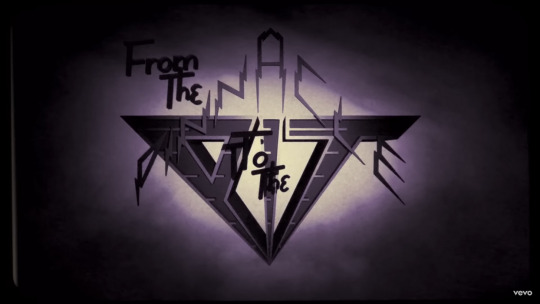
Freemasons are everywhere!
Considering Meliora, we are inevitably faced with its duality: on the one hand, it’s a down-to-earth story about a satanic musical group controlled by the Clergy. On the other hand it’s a legend of the city of Meloria, a kind of Gotham of this fictional universe. Even Papa seems to have two incarnations: a physical and a spiritual one. But the two worlds are not only the dichotomy of matter and spirit. The video shows two levels of the metropolis: the celestial - the world of thunder and lightning, power and electricity, and the subterranean - the world of the poor and the catacombs, the underground temples "under the streets". The society of Meloria is stratified, the upper classes exist at the expense of the lower classes, who bust their hump, generating electricity for their masters and covering the foot of skyscrapers with their bones. The totalitarian regime described in the pages of the Prologue is the oligarchy's way of keeping power in its hands and suppressing any expression of free will from the enslaved people.
“Spies are everywhere. Their eyes are behind the screens of your televisions and devices, their ears attentive to every frequency in the air. Everything is mediated, pre-packaged, and pressure sealed, your lives pre-ordained.”
The watchful airships in the video are labeled grucifixes, but don't let that put us off: they are "angels," agents of the ruling class, an enemy force opposed to Papa Emeritus.
"What if man could harness the power of a god?" the Headmaster asks the protagonist. "In a sense, he would need god no longer." It may be recalled here that Meliora is essentially an album about a world without God. That's exactly how the Nameless Ghoul put it in an interview, which is cited in Revolver magazine. “Spirit Absent” ("spirit absinthe") is “Deus in Absentia”, absent God. It is a world in which man is doomed to choose his own path without prompting from above. Modern man, the man of the era of modernism, seeks to curb the laws of physics, to put heavenly fire at his service. We are getting very close to the image of Prometheus in this story.
“You have been chosen to wield this power,” the Headmaster tells the boy. “Here we are the gods.” Then he sends the protagonist to the top of the building on what looks like an elevator, which symbolizes his ascent through the lodge ranks.
The woman reveals to the protagonist that the deity called demi-surge is the source of the power that moves the gears of the city. And the same power is used to enslave its people. It is their backs that we see bowed before Moloch. The vision is replaced by the sight of a lavish ball. “Through industry, man can harness this power and attain all that which he desires!” - the woman tells and invites the character to join.

This situation is also described in the Prologue:
"The world since he was last seen has changed. Called Moloch by some, the great industrial machine has been grinding away, grinding everything and everyone down in the process."
Historically, Moloch was an ancient Semitic deity to whom human sacrifices had to be made. In the 1927 film "Metropolis" Moloch is represented by an industrial machine with an insatiable maw that devours people who labor in its bowels. And since the music video shows us the 20s of the 20th century, this machine operates on electric power. So, in this story Moloch symbolizes the dark side of progress turned against people.
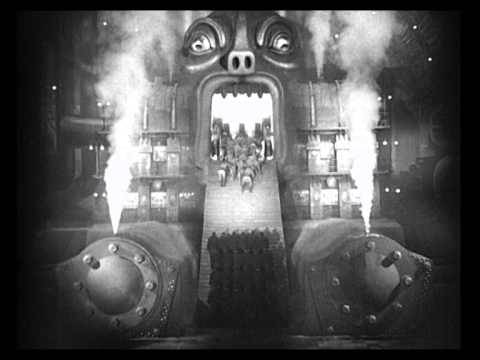
Moloch in the “Metropolis” movie
The protagonist realizes that the lodge is using ordinary people as fuel for its luxurious life. He is not ready to accept this, so he pushes the woman away and, scattering, jumps from the roof of the skyscraper, from the pinnacle to the pit. There's an important element not to miss here: while he's climbing to the top of the tower before jumping, he's struck by lightning. In that moment he perhaps becomes heir to the mystical power of the demi-surge. By this Papa gains the dramatic ability to shoot lightning from his hands (and a little from his eyes).
As a man of the modern era and a resident of godless Meloria, the protagonist is free to choose how to dispose of this power. Therefore, when he becomes Papa Emeritus, already at the base of the skyscraper, he proclaims that the light should belong to the people. Like Prometheus, who stole the divine fire, he is ready to give it selflessly to the people, so that they can curb the natural force themselves. This similarity must be what the following the Prologue fragment hints at:
“…some still remember the old tales of those who tried to defy the gods. It was said they stole the fire from heaven, or called themselves equal.”
The people who rally around the sacrificed hero become Papa's flock, which is mentioned in the text:
“He is a shepherd of black sheep, the sewers are his cathedral. Here in the darkness they follow the path of the hero’s journey, the necessary travel to the underworld to become transfigured, to become something new.”
The Hero's Journey is a concept invented by Joseph Campbell to describe a monomyth. This archetypal story depicts the way of personality formation, accompanied by psychological transformation. According to the plot, the hero goes on a journey, meets a mentor, passes through a gateway where temptations await, which he must resist. Then he goes to the abyss, where he undergoes a transformation, along with acquiring the gift of the gods, and eventually returns reborn.
Doesn't that ring a bell?
Probably "From the Pinnacle to the Pit" is also a statement about art. Electricity can be perceived as a metaphor for creativity. It is a bit of heavenly power, which the creator (musician) draws from somewhere in the higher spheres and gives to his audience for free. Here Tobias himself appears as a giver of light.
The story of Mysterious Spectre will be continued in the "Square Hammer" video, where we are told that he successfully wages war with local oligarchs, wresting power from them. Let's wish him luck and pay attention to the similarity of Papa's story to two other mythological characters.

Mysterious Spectre in the background of the moon. Handsome as hell.
The cover of the single "From the Pinnacle to the Pit" shows us Papa as Icarus. Let us recall that this ancient Greek young man daringly ascended to the sun, scorched his wings with its heat and fell from heaven to earth, losing too many feathers attached with the easily melting wax. Here we can exclaim after the prophet Isaiah: "How you have fallen from heaven, morning star, son of the dawn!" Because the image of Icarus in this song is combined with the image of Lucifer. In Wikipedia we can read: "Lucifer is the Latin name for the morning appearances of the planet Venus. It corresponds to the Greek names Phosphorus Φωσφόρος, "light-bringer", and Eosphorus Ἑωσφόρος, "dawn-bringer". The entity's Latin name was subsequently absorbed into Christianity as a name for the devil."
Or maybe he didn't fall, but jumped, as the Prologue directly tells us. A man of the modern era is free to choose his own destiny. And it is up to him to decide whether he will be thrown down from heaven or will take a step into the precipice himself, without waiting for a kick from above. Because there is no other way than "from the pinnacle to the pit". Such is the Hero's Journey.

“One figure was considered so prideful he was imprisoned in a pit where he gathered a legion to plan a great rebellion. Now they are merely stories to scare children, to remind them that defiance is a sin. Papa Emeritus III will steal your breath, the parents say. He will unscrew your hands and feet. He will take your eyes.”
Here the image of Papa is so merged with the image of Lucifer that it is difficult to understand who the text is talking about. It seems that the figure of Papa has been defamed: now he is a monster of the underworld, who is used to scare children to make them obedient. He was transformed from a light-bearer into an evil character through slander. Once again we are faced with an almost direct analogy with the Devil. By the way, isn't that why Papa addresses Cirice with the words "I know your soul is not tainted even though you've been told so" that he himself has been stigmatized, presented as a villain? Isn't this the essence of the fall and the punishment?
However Papa Emeritus appears to us: whether he is a rebel, a Melorian revolutionary who made the oligarchs tremble in their skyscrapers, a hero of the common people who brings the light of electricity and freedom to the populace, a fallen angel banished from heaven for his defiant thoughts, or a chthonic demon to scare children, he is a figure who appeals to our unconscious layers through mythological archetypes. Only one question remains: are you, dear reader, ready to follow Papa Emeritus into the abyss, taking the path of rebirth, feeling the halo above your head melting and being replaced by a mitre with an inverted cross?

#papa emeritus iii#terzo#the band ghost#ghost#papa emeritus#papa emeritus 3#papa emeritus lll#ghost band#ghost bc#meliora#meloria#ghost lore#ghost theory#papa terzo#papa iii#terzo emeritus#tobias forge#mysterious spectre
105 notes
·
View notes
Text
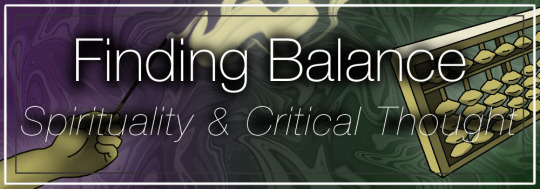
Title: Finding Balance: Spirituality & Critical Thought
Related Articles
What is Witchcraft?
Bias in Witchcraft
Spell Logs
Dualities
Content Creation Vs. Personal Practice
Spell Design
Spell Dictation
Spellcasting Basics
Finding Balance
Finding a balance between deep sacred connection and critical thinking in our magical practice becomes an art of integration. It requires us to honor and nurture the emotional and intuitive dimensions that anchor us to the mystical, while simultaneously engaging in rigorous analysis that hones our understanding and sharpens our discernment. By nurturing this delicate equilibrium, we embark on a transformative journey that embraces both the ethereal heights of the numinous and the grounded foundations of rational exploration.

Keeping What is Sacred
Magic, a subject that has captivated human curiosity for ages, extends beyond illusion and trickery. It delves into the depths of human emotion, evoking profound sensations of awe and sacredness. In the pursuit of understanding what magic truly feels like, it becomes apparent that its essence lies in the ability to establish and nurture a deep connection with one's practice. This connection goes beyond mere intellectual comprehension and encompasses a profound emotional engagement.
To grasp the true nature of magic, one must recognize the significance of feeling a sense of profoundness. This emotion arises when one encounters something that transcends the ordinary, igniting a feeling of astonishment and reverence. It is an experience that goes beyond the boundaries of rationality, encouraging us to explore the mysteries of existence. In witchcraft, this profoundness stems from the recognition of the extraordinary within the ordinary, the extraordinary concealed within the fabric of everyday life.
Feeling amazed pushes the boundaries of what we believe to be possible, expanding our horizons and inviting us to question the limits of our knowledge. Amazement manifests when we witness phenomena that defy conventional explanations, leading us to contemplate the hidden forces at play in the universe. Awe arises when faced with the vastness and grandeur of the world around us, awakening a sense of humility and interconnectedness. It reminds us of our place in the cosmic order and encourages us to contemplate the intricate web of existence. In magic, awe emerges when we encounter practices or rituals that connect us to the natural world, reminding us of the interplay between the microcosm and the macrocosm, and highlighting the profound interdependence of all things. Sacredness, the final pillar of magical experience, emanates from a deep reverence for the practice itself. It is the recognition of the inherent value and significance of the rituals, ceremonies, or acts of creation that form the core of magical engagement. The sacredness of magic lies in the belief that these practices possess transformative power, connecting us to something greater than ourselves. It is through this reverence that we infuse our practice with intention and dedication, forging a profound and enduring bond with the magical arts.
In order to fully engage with the magic that lies within our practices, it is crucial to nurture and sustain these profound emotions—profoundness, amazement, awe, and sacredness. These emotions are not fleeting, superficial experiences but rather foundations upon which the magical experience is built. They foster a deep connection with our practice, enabling us to tap into its transformative potential and embrace the mysteries that lie beyond the veil of the mundane.
Keeping what is sacred entails cherishing these profound emotions and allowing them to guide our journey through the magical realm. It requires us to approach our practice with a sense of wonder, curiosity, and reverence, ensuring that our engagement remains meaningful and enriching. By cultivating these emotions, we unlock the true essence of magic, embracing its transformative power and experiencing the extraordinary in the ordinary.

Retaining a Critical Eye
Critical thinking within witchcraft embodies a multifaceted approach that engages the mind in a systematic and analytical manner. It encourages practitioners to question, evaluate, and challenge beliefs, ideas, and concepts that underpin their craft. Far from negating the mystical elements of witchcraft, critical thinking acts as a compass, guiding practitioners to distinguish between reliable information and unfounded claims. It enables them to discern between what resonates with their personal truth and what may be mere speculation or fabrication.
Understanding the significance of critical thinking in witchcraft unveils its ability to safeguard practitioners against blind adherence to dogma or misleading information. By cultivating a critical eye, practitioners can scrutinize the sources of knowledge they encounter and assess them for validity, reliability, and coherence. Critical thinking becomes a shield against misinformation and misconceptions that may permeate the realm of witchcraft, allowing practitioners to build a solid foundation of understanding based on evidence, reason, and sound judgment.
Integrating critical thinking into daily magical practices is crucial for developing a well-rounded and informed approach. One way to achieve this is by cultivating an attitude of curiosity and inquiry. Practitioners should actively seek out diverse perspectives, explore different sources of information, and remain open to new ideas and interpretations. This mindset enables practitioners to continuously expand their knowledge, challenge preconceived notions, and refine their understanding of witchcraft.
Another vital aspect of integrating critical thinking is the development of analytical skills. Practitioners can hone their ability to analyze information, evaluate arguments, and identify logical fallacies. This empowers them to critically assess rituals, spells, or claims made within the witchcraft community. By applying logic and reason, practitioners can make informed decisions, distinguishing between practices rooted in tradition and those lacking empirical support.
Moreover, embracing skepticism as a tool for inquiry is essential within the realm of critical thinking in witchcraft. Skepticism, in this context, should not be misconstrued as dismissiveness or cynicism but rather as a healthy dose of questioning and inquiry. By maintaining a healthy level of skepticism, practitioners can avoid falling prey to unsubstantiated claims or unrealistic promises. They can embrace a balanced perspective that allows room for exploration while retaining a discerning eye.

Keeping the Scales Balanced
In the realm of magic, the pursuit of critical thinking can sometimes evoke concerns about the potential sterilization of the mystical arts. The fear of analytical scrutiny eroding the emotional and sacred connections inherent in magical practices is not unfounded. However, it is essential to recognize that finding equilibrium between critical thinking and magical experience is key. By exploring this delicate balance, we can foster a harmonious integration of rational thought without undermining the profound and enchanting aspects of personal spiritual encounters.
The notion of critical thinking can evoke images of sterile analysis and detached examination, which seemingly stand in contrast to the emotive and sacred dimensions of magical experience. However, it is crucial to approach critical thinking as a tool rather than a detractor. When wielded appropriately, it can complement and enhance the magical journey. Critical thinking offers the opportunity to examine beliefs, rituals, and experiences with a discerning eye, ensuring that they align with reason and evidence. It enables practitioners to navigate the vast landscape of spiritual exploration without blindly accepting unfounded claims or succumbing to cognitive biases.
To strike a balance between critical thinking and emotional or sacred connections within magic, practitioners must acknowledge the value of both. Emotional and sacred connections serve as conduits for personal experiences, imbuing them with meaning and significance. These connections enable practitioners to forge a deep and intimate relationship with their craft, allowing magic to become a source of inspiration, transformation, and empowerment. Emotional and sacred connections form the tapestry that weaves together the fabric of magical experience.
However, the integration of critical thinking need not detract from these connections. Rather, it can enrich and refine them. The key lies in embracing a nuanced approach that encompasses both rational thought and emotional engagement. Critical thinking provides a framework for evaluating personal spiritual experiences, encouraging practitioners to reflect on their own beliefs and interpretations. It allows for a deeper understanding of the mechanisms at work in spiritual encounters while preserving the awe, wonder, and mystery that make them magical.
An important concept in navigating the balance between critical thinking and magical experience is UPG (Unverified Personal Gnosis). UPG refers to personal spiritual experiences and insights that may not be universally accepted or supported by external sources. While UPG holds immense value for the individual, it is essential to rationalize and contextualize these experiences within the framework of critical thinking. This process involves reflecting on personal biases, considering alternative explanations, and examining the internal and external factors that may have influenced the experience. By undertaking this introspective and analytical exploration, practitioners can embrace the magic of their personal spiritual encounters while incorporating critical thought.

It is Natural
Within the realm of magic, the adoption of a critical approach may occasionally trigger periods of doubt. This is a natural consequence of engaging in a practice that delves into the unknown and challenges conventional beliefs. Recognizing the normalcy of doubt is paramount, as it allows practitioners to navigate their magical journey with authenticity and introspection. Moreover, understanding when to step away from magic and take a break can prove invaluable in restoring clarity and rejuvenation. Lastly, it is essential to resist the allure of mystical experiences and not neglect critical thought, as both are integral components of a well-rounded and balanced approach to magic.
Doubt, though often seen as a hindrance, is an inherent aspect of the human condition and, by extension, magical exploration. When undertaking a critical approach to magic, practitioners may question their beliefs, rituals, or experiences. This questioning should not be regarded as a sign of weakness, but rather as a testament to an inquisitive mind and a desire for deeper understanding. Doubt propels practitioners to examine their beliefs and motivations, enabling growth and self-reflection within their magical journey.
In certain instances, recognizing when to step away from magic and take a break becomes crucial. Engaging in continuous magical practice can be mentally and emotionally demanding. It is during these moments of respite that practitioners gain clarity and perspective. Stepping away from magic allows for introspection, allowing one to recalibrate and reevaluate their practices without the pressures of immediate engagement. By embracing the occasional break, practitioners can return to their magical pursuits with renewed vigor and a fresh outlook.
However, it is imperative not to succumb to the allure of mystical experiences and disregard critical thought altogether. While mystical encounters hold an undeniable fascination, practitioners must be wary of allowing these experiences to overshadow the importance of analytical thinking. By maintaining a balance between the mystical and the critical, practitioners cultivate a holistic approach that incorporates both awe-inspiring encounters and discerning analysis. This equilibrium ensures that magical experiences are grounded in rational exploration while embracing the profound mysteries that lie beyond the boundaries of everyday perception.

Interested in my other articles? You can find my masterpost here.
Patron Shoutouts!
Megan Kipp
Jinsu
Ing Mar
Cosmicauquamarie
Thank you for your continued support! My patrons help me maintain the drive to create content and help me keep food in my pantry.

My patrons of Mystic tier and higher had access to this article a week before it was public! To see other perks of supporting me, click here!
This article was reviewed and edited by ChatGPT
#beginner witch#baby witch#eclectic witchcraft#witchcraft#witchcraft community#witchcraft guide#witchcraft resource#witchcraft 101#informational post
85 notes
·
View notes
Text
Um, hey guys? Where exactly *is* The Fairy King's Forest?
That seems like a dumb-fuck question to ask, especially for me to ask, but there's this underlying issue.
This is really more of a genuine question to people who are better with the translations and original Japanese versions than I am. And not really analysis.
We know where the forest is. Like we have maps, it's on maps of Britannia.

But... is it actually in Britannia?
Because of translation and issues with localizing vernacular, there are a few things with Fairies that have always tripped me up a little. Like switching between saying "Holy Tree" and "Sacred Tree". I always assume they're interchangeable terms for the same tree, but I'm never 100% sure. Three different trees as this point are all refered to by these words;
The one in the Fairy Realm that was birthed by Chaos and created the Fairy Realm and the Fairy Clan.
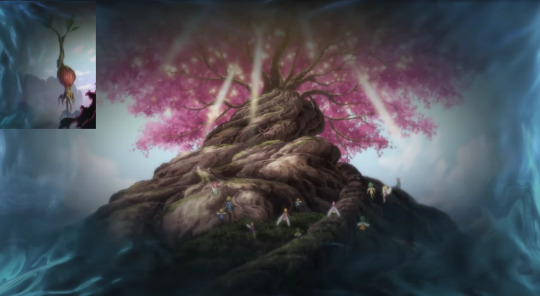
The tree in the old Fairy King's Forest
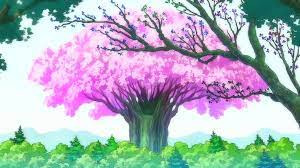
And the one in the new forest
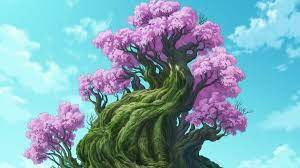
They're all called "The Sacred Tree" even though, at least the new one for sure, is a separate structure we've seen start from a new seed.
So what I'm unsure of, based on how things have been said in both the manga and the anime, is weather the Fairy King's Forest is technically in Britannia or if it's just inside the Fairy Realm. Like, I know we're told it's on the border - or acts as the border? - but that makes it's physical location a little tough for me to grasp. When someone is in the Fairy King's Forest, are they technically in the Fairy Realm?
#seven deadly sins#nanatsu no taizai#four knights of the apocalypse#mokushiroku no yonkishi#7ds#nnt#4kota#7ds fairy#nnt fairy#4kota fairy#7ds discussion#nnt discussion#4kota discussion#I dont know#maybe im dumb#I wrote this directly after waking up yesterday#like this is the thought I woke up#literally#and I am only now getting around to adding the visual aids cuz I forgot#and I've up for 24 hours at this point...#So long story short I'm not 100% sure this is coherent cuz I wrote it right after waking up and finalizing it sleep deprived...#at the very least I can be reasonably confident all the words are spelled right...
21 notes
·
View notes
Text
Trace the steps of two researchers as they delve into the curious case of the Knights of the Star, uncovering clues to the existence of a giant sacred pentagram hidden within the heart of France. Founded by King John II of France, the existence of labyrinth cathedrals reveals centuries-old clues to ancient connections between faith, history and symbolism.
Through meticulous research and insightful analysis, witness the unfolding of a captivating narrative that intertwines the realms of religion, royalty and sacred geometry. Embark on a quest to unravel the secrets of the Knights of the Star and the transcendent mysteries they guard within the sanctified landscapes of France.
15 notes
·
View notes
Note
I absolutely ADORE your analysis about LOZ and it’s really made me think more about the franchise (and BOTW in particular, which I… may have a slight addiction to playing?)
You’re the Zelda Person to me, so I was wondering if you had any ideas on what would happen if Link or Zelda died before their cycle was complete. Would the world just… immediately reincarnate them? Would it be some sort of irreversible failure and Ganondorf would win?
(also, I’ve heard theories that there was supposed to be someone who isn’t Ganondorf who would get the Triforce of Power, but because of his interference they were just never found/never found the Triforce of Power and I was wondering what you thought about that)
Canonically this has happened! i don't even need to theorize because we have a genuine canon instance of a link dying before he defeats ganon lol. I don't know how familiar you are with the loz game timeline, but due to a time-travel mechanic in ocarina of time, the timeline splits into multiple potential outcomes after oot. there are three separate ways the confrontation with ganondorf in oot can go for the hero of time--he can win and go back in time, win and stay an adult, OR he can lose and fall at the hands of ganondorf. in the timeline where the hero of time dies, the next reincarnation cycle takes place during a link to the past. this game is a few hundred years or so after the death of the hero of time and oot's zelda, so we actually do know for certain that the reincarnation doesn't happen immediately. to keep hyrule safe after the hero of time's death, oot's zelda and the sages seal ganon into the corrupted sacred realm, but the damage to hyrule has already been done and it enters an era of decline. by the time alttp link is born, hyrule is a much smaller and less powerful kingdom than it was during oot. however, alttp ends with the new link and zelda successfully defeating ganon, so one link's failure doesn't necessarily mean the end for hyrule either!
as for your second question, there are a couple instances I can think of of someone who isn't ganon trying to get their hands on the triforce and/or generally fuck with hyrule, but usually these characters are secondary antagonists serving ganon somehow. the only instance i can think of of an antagonist who ISN'T directly a minion of ganon is vaati, who appears in minish cap & the four swords games. vaati explicitly wants power and goes after the triforce for this reason, but it's unclear if he's a demise incarnation or just some idiot who wants to be king. (i think he probably isn't a demise incarnation solely because he was originally minish, not human, but that deals with a bunch of lore stuff we don't need to get into rn.) so yeah, there are other people who occasionally try to get at the triforce, but if ganon exists in their version of hyrule they're usually serving him.
If you mean someone other than ganon inheriting the physical power of the triforce of power post-oot-triforce-split, most games that follow oot are still dealing with oot's ganondorf because for whatever reason he really doesn't like to stay dead. in a hypothetical instance where he DID reincarnate, i don't think there's any reason the triforce of power wouldn't end up with the "new ganon" (meaning the new incarnation of demise, whatever form it might take.) if wisdom and power have reliably followed around the same hero and princess's bloodine/spirits for hundreds of years, i see no reason why power wouldn't also follow ganon/demise's spirit around after being initially bonded to it. It's possible that a new ganon might not LIKE inheriting the power or choose to use it in a different way than his predecessors, but i think on some level it's always going to be a version of ganon who ends up with it.
#had to break out the historia for this one. society if the timeline wasn't so awful to remember#asks
58 notes
·
View notes
Text
The Family of the Hero: A Thorough Analysis of the Canonical Bloodline Shared by Every Link in the Legend of Zelda Series - Part 1 of 2
Notes before reading:
First, this is a very long essay. If you would like a basic summary of the Knights of Hyrule, the family that all Links are canonically born from, it will be provided at the bottom of this piece. However, all of the quotes and their sources will be provided throughout the larger article, not the summary. If you disagree with anything in the summary, I would ask you to look over the full article and find where it is mentioned alongside its in-game textual evidence before disputing it.
Second, there are several other potential Knights of Hyrule references and mentions throughout the series that are not discussed here. I intentionally left them out because I wanted to focus on the most important connections to the Knights of Hyrule and the appearances of the Knights and the techniques, characters, and lore pertaining to them. This was done so as to best illustrate an overall view on what the Knights of Hyrule are and how they appear in the series. I intend to create addendums that will look at each game individually and the possible Knights of Hyrule connections they have in the future.
All of the in-game text utilized is from the most recent incarnations of each specific entry.
Special thanks to: Sidier, ymcan64, hwrdjacob, Chateau LonLon, Sean D. Walsh, Lady Sophie, Rinkuto, Ciaroon, and the members of the Cloudmodding Discord server.
—
When most people think of the magical families of the The Legend of Zelda series, they think of the bloodline of the Royal Family, started by the mortal incarnation of the Goddess Hylia, or the bloodlines passed between certain groups of Sages. However, there’s an important bloodline that is often left out of these discussions: the bloodline of the Knights of Hyrule. This is the bloodline that every Link in the series comes from. Contrary to the popular belief that Link doesn’t share a bloodline, all Links stem from the Knights of Hyrule, and thus every Link is a blood relative of each other, even if distantly. To shed light on this topic, I would like to go step by step chronologically through the series by release date and discuss the appearances and mentions of the Knights of Hyrule. Let’s start with the first game that they are ever mentioned in: The Legend of Zelda: A Link to the Past, specifically following the updated text from the Game Boy Advance remake and the manual from the original release.
A Link to the Past
The manual briefly touches on what it refers to as just The Order of Knights (騎士団), stating that, when evil began to flow forth from the Sacred Realm, the King of Hyrule summoned forth the Seven Sages as well as the Order of Knights in tandem to seal away this great evil.
ハイラル王は、ハイラルに住む七人の賢者達と騎士団を呼び、悪の原因を封印するよう命じました。
The king of Hyrule sent for the seven sages living in Hyrule, and the Order of Knights, and ordered them to seal the source of evil.
Manual (A Link to the Past) Translated by Johan
In a great battle, The Order of Knights used their bodies as shields, sacrificing themselves to protect the Sages, who were working to seal the entrance to the Sacred Realm. They succeeded, but at a great cost - The Order of Knights were all but wiped out, with only a handful of them remaining. The manual then says that this conflict - which would come to be known as the Imprisoning War, or, in the Japanese release, the Seal War (封印戦争) - would be passed down through history, along with the sacrifices made by the The Order of Knights in that war.
多くの犠牲をはらったこの戦いは、「封印戦争」として後世に語り継がれています。
The many sacrifices paid in this fight would be known as the "Seal War" in the future ages.
Manual (A Link to the Past) Translated by Johan
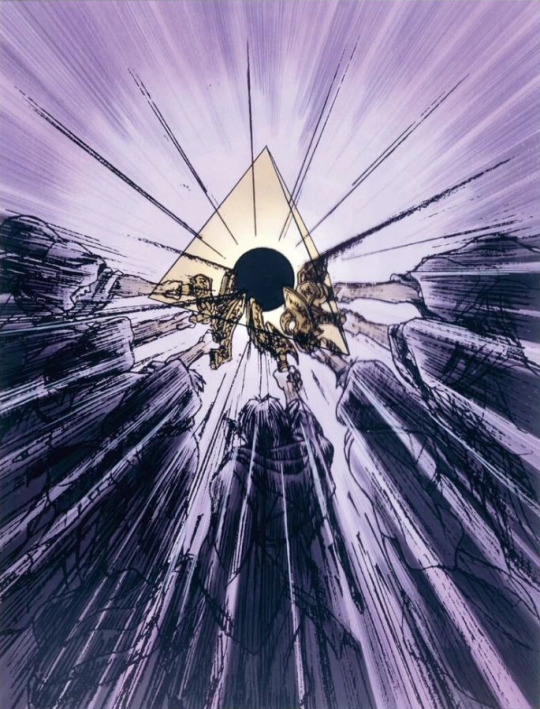
The game proves the manual right, as the Knights are mentioned multiple times throughout A Link to the Past, where they are most often referred to as the Knight’s Family (ナイトの一族). The first mention of the Knight’s Family is at the beginning of the game - as Link’s uncle lay dying in the secret entrance to Hyrule Castle, he informs Link with his last breath of the technique passed down through the Knight’s Family - the Spin Attack, or the Spinning Slash (回転斬り).
ナイトの一族に伝わる剣の秘術 お前に... さずけよう。 よくきけ...Bボタンを押し続け 剣に力をためる. ボタンをはな した時、その力が現れる.
I will teach you the secret sword skill, passed down through the Knight’s Family.... Listen carefully. Hold down the B button. When you release the button, the power will be unleashed.
Link’s Uncle (A Link to the Past) - Translated by Sidier
However, we don’t get a thorough description of the Knight’s Family until after acquiring the Pendant of Courage at the Eastern Palace. At this point, Sahasrahla, a descendant of the Seven Sages, gives us a lot of information pertaining to the Knights:
おお、なんと『勇気の紋章』を 手に入れたか...。 では、ワシの 知っている話を教えよう。
その昔ハイリアの王家を守り つねにその盾となるかくこを 持った者たちがおった。彼らは、 ナイトの一族と呼ばれ 勇気の紋章を司り、剣をもって その意をつくしたのじゃ そして、大きなわざわいが王家 をおそう時、ナイトの一族から 勇者が現れるとも伝えられた。
Oh, you have obtained the Crest of Courage.... Now, let me tell you a story I know. Long ago, there was a group of men who protected the Royalty of Hylia. They were called the Knight's Family. They bore the Crest of Courage and expressed their feelings through swordsmanship. It was said that when great evil befell the Royal Family, a Hero would be born from the Knight’s Family.
Sahasrahla (A Link to the Past) - Translated by Sidier
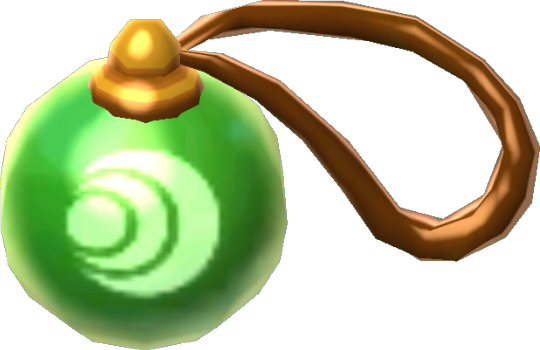
What Sahasrahla tells us here is a basic summary of the Knight’s Family - long ago, the Knight’s Family protected the Royal Family of Hyrule, and it was this very same bloodline that the Hero would emerge from whenever disaster would waylay the Royal Family. However, during the Imprisoning War, most of them were wiped out, and thus it was believed the Hero would never appear again. What this tells us is that Link, the Hero, in every iteration, stems from this bloodline, meaning all Links can tie their lineage back to the Knight’s Family. This is further established by the Maiden who Link rescues from Skull Woods, who says the following:
「大いなる災い」の 予言は知っていますか? 私は、こう聞いています もし、悪しき心を持つ者が トライフォースを手にしたなら いずこかに「勇者」が必ず現れ この「大いなる災い」の元となる者を打つだろう しかし、「勇者」が倒れた時は 悪しき心に世界は、覆われてしまうであろう、と そう、「勇者」になれるのは ハイリアの王家を守っていた ナイトの一族だけのはず あなたには、その血が流れて いたのね。では、ナイトであり 勇者であるあなたにお願いです 必ず、ゼルダ姫を救い出して 下さい。そして、悪しき心の者 を討ち果たして下さいね!
Do you know the prophecy of the "Great Calamity?” This is what I was told: If an evil one wereto lay their hands on the Triforce, the Hero will appear somewhere and defeat the harbingerof the "Great Calamity.” But if the Hero were to fail in their quest, the world would be shrouded in evil. Yes. Only one of the Knights that protected the Royal Family can become the Hero, which means that you're a blood descendant of the Knights. Please, brave Knight and Hero, Rescue Princess Zelda, and defeat the foe with an evil heart!
Skull Woods Maiden (A Link to the Past) - Translated by Sidier
With this, she further corroborates what Sahasrahla states about how the Hero appears from within the Knight’s Family. She also expands on the circumstances of the Hero appearing, revealing that the Hero is destined to appear from the Knight’s Family when an evil hearted individual gets the Triforce. Something of significance to point out is also that, in her last line, she refers to Link as a “Knight.” This means that to be a member of the Knight’s Family and have the title of Knight, you do not have to officially have a vocational role as an actual knight; merely being a member of the Knight’s Family is enough to possess that title.
While this would otherwise be the end of the general context provided by A Link to the Past on the Knights of Hyrule, the Game Boy Advance remake actually adds a side quest involving the lumberjacks who live west of Death Mountain. Upon completion of this side quest, and speaking to Q. Bumpkin, he has this to say:
よう,リンク!こたえはわかったかい?どれどれ、カゴを見せてみなうわ一つ、正解だぁ!ままま、 まいった! あんたには まいった!あんたにはかなわねエーや。さいごにおいらの家に伝わる秘密の剣のワザを教えるよ。
Hey, Link! Did you find the answer? Let's see the basket. Oh, no, no, no, no! You got me! You're the greatest! Now, I'm going to teach you our family's secret sword technique as a parting gift.
Q. Bumpkin (A Link to the Past) - Translated by Sidier
He teaches Link a sword technique that he describes as being passed down in his family. While it goes unnamed in the game itself, in the Nintendo Official Guidebook: The Legend of Zelda: The Triforce of the Gods & Four Swords (任天堂公式ガイドブック ゼルダの伝説 神々のトライフォース&4コの剣), published by Shogakukan, we get this excerpt:
敵とのバトルで最も多用するのが剣。基本ワザは以下の4種類だが、ほかに 「4つの剣」と連動した"大回転斬り"というワザもある(くわしくはP171)。
Swords are used most frequently in battles with enemies. There are the following four basic moves, but there is also a move called the "Great Spinning Slash" that is linked to the "Four Swords" (see p. 171 for details).
Shogakukan Guidebook - Translated by Sidier
(Note: While I am hesitant to use anything outside of the games or manuals as evidence, the Great Spinning Slash (大回転斬り) is consistently used as the name for the sword technique going forward and will appear multiple times across future entries. Therefore, I believe it is appropriate to use the guidebook as a source for the name in this instance.)
Link can use this technique to perform continuous Spin Attacks multiple times, though it will drain Link’s magic. Because of the Bumpkin family’s sword technique being a variation on the Spin Attack, which as established earlier is passed down through the Knight’s Family, it is very likely that the Bumpkin household is also related by blood to the Knight’s Family, and its members are descendants of the few knights who managed to survive the Imprisoning War, just like Link and his uncle.
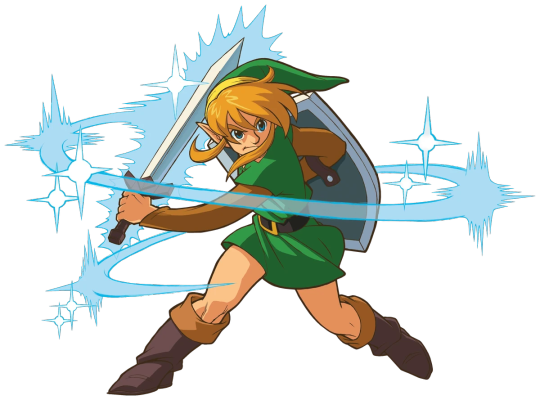
With this, the Knight’s Family as shown in A Link to the Past can best be summarized as follows: The Knight’s Family are a bloodline of knights that served the Royal Family of Hyrule. From their bloodline, the Hero would appear whenever disaster would waylay the Royal Family, or when an evil person had acquired the Triforce. Passed down amongst them were certain sword techniques, such as the Spin Attack and the Hurricane Spin. In the Imprisoning War, their numbers significantly dwindled, but their bloodline lives on through their descendants, with their skills and techniques surviving alongside them.
Link’s Awakening
The Knight’s Family is only briefly mentioned in Link’s Awakening, in a book in Mabe Village’s library. It informs the player of how to perform the Spin Attack.
ある一族の血を引く者だけに伝わる秘剣がある Bを押し続けて力をためろ! たまったらボタンをはなすのだ!
There is a secret sword technique that has been passed down only to those with the blood of a certain family. Keep pressing B to save your power! Release the button when it's full!
Mabe Village Library Book (Link’s Awakening) - Translated by Sidier
This tells us more of what we already learned in A Link to the Past; the Spin Attack is a technique passed down by a certain family, which as we know is the Knight’s Family. Otherwise, there is nothing else of substance to really focus on in Link’s Awakening, if it weren’t for the 2019 Nintendo Switch remake.
The 2019 remake the design of Link’s shield to instead be that of the Hylian Shield, a shield that would be formally introduced in the series in The Legend of Zelda: Ocarina of Time. Keep that in mind as we move onto that entry and discuss its connections to the Knight’s Family.
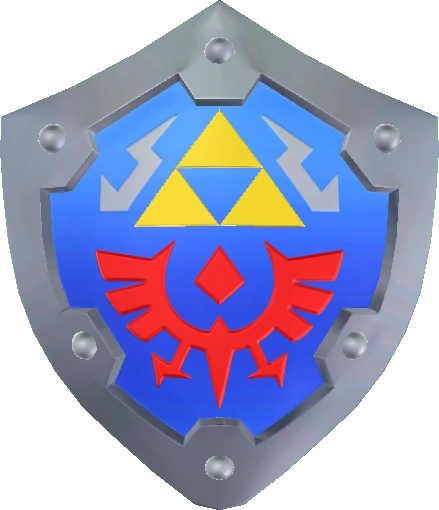
Ocarina of Time
The most substantial connection this game has to the Knight’s Family is in the form of the Hylian Shield. The description provided by the Bazaar Owner states the following:
ハイリアの盾(たて) 80ルピー ハイリアの騎士が持つ 大きな盾。 炎攻撃を 防ぐ。
Hylian Shield 80 Rupees - Hylian Knight's large shield. It protects against fire attacks.
Bazaar (Ocarina of Time) - Translated by Sidier
This establishes that the Hylian Shields are utilized by the Hylian Knights (ハイリアの騎士). While technically the Knight’s Family aren’t explicitly mentioned by name, future entries will further clarify that members of the Knight’s Family - primarily the various Heroes in the series - are the ones who are associated with using the Hylian Shield, which also explains why Link’s Awakening retroactively makes Link’s shield, which he acquired from his uncle, a version of the Hylian Shield.

In summary, this is the first game in the series that associates the Knight’s Family - who in this specific entry are just referred to as Hylian Knights - with the Hylian Shield.
Majora's Mask
In Majora’s Mask, we see the appearance of a strange new shield, which is referred to as the Hero’s Shield. Visually, it very clearly is intended to be a kind of Hylian Shield, and was likely specifically created for Link given its small size. As the Knights of Hyrule are associated with the Hylian Shield and Link was specifically given a custom, smaller version of a Hylian Shield, it’s interesting to note this association between Link and the Knights of Hyrule. This should be expected, given the Hero’s familial ties and origins to the Knights.
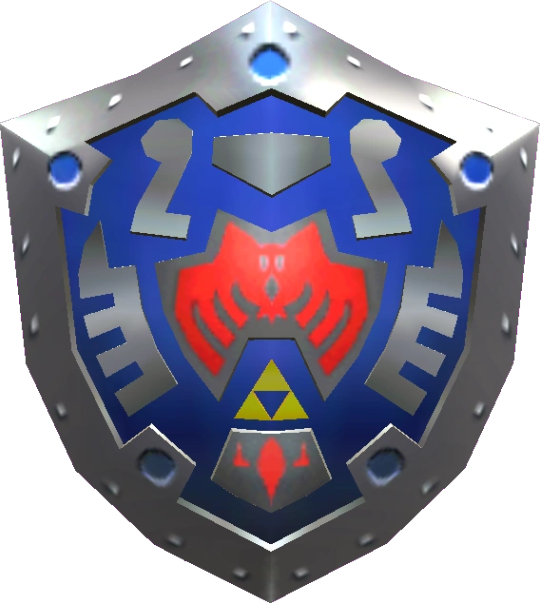
Oracle of Seasons/Ages
While it’s a small appearance, in the introduction of Oracle of Seasons, we’re introduced to Din’s traveling troupe. Talking to the members will result in one of them saying the following about their identity as members of a troupe:
でもそれは 世をあざむくかりのすがた 大きなこえではいえませんが じつはわれらは ハイラルのきしなのです
The thing is, that’s just an alias we’re using to fool the world. I can’t say it very loud, but we’re actually Knights of Hyrule.
Knight (Oracle of Seasons) - Translated by Sidier

This is the first time in the series in the Japanese source text where they’re called their most prominent and well known name, the Knights of Hyrule ( ハイラルのきし). Given the relative placement of Oracle of Seasons and Oracle of Ages on the timeline, this would mean that, following A Link to the Past, the knightly order was restored in some respects after their destruction in the Imprisoning War.
The only other possible reference to the Knights of Hyrule is the end of Oracle of Ages, where Ralph uses a variation of the secret sword technique from A Link to the Past. However, given that he doesn’t charge his blade up, it’s likely that this is intended to be Ralph stumbling around, and not him actually performing the technique.
Four Swords Anniversary Edition
In Four Swords Anniversary Edition, after clearing the Hero’s Trial, or in the Japanese release, the Training Grounds (修練場), Link learns a new sword technique:
『修練場』 をクリアした。 大回転斬りをおぼえた! 回転斬り中にB ボタン連打で 連続回転斬りだ!
The "Training Grounds" is cleared. I have learned the Great Spinning Slash! Press the B button repeatedly while performing the Spinning Slash to perform a continuous Spinning Slash!
Flavor Text (Four Swords Anniversary Edition) - Translated by Sidier
Link learns the Hurricane Spin, or in the Japanese release, the Great Spinning Slash (大回転斬り.
This is the same sword technique that was taught to Link by Q. Bumpkin in A Link to the Past, so, while small, this is a continuation of the passing on and learning of the techniques that belong to the Knights of Hyrule.
The Wind Waker
The Wind Waker holds a significant amount of revelations regarding the Knights of Hyrule and their lore as the series begins to move into the modern era. To begin with, we learn at the beginning of the game that the Hero’s Shield, a shield that was said to have been utilized by a hero from the past, is passed down through Link’s family. This coincides with what we learned in A Link to the Past, where the Hero appears exclusively from within the Knight’s Family, so it would make sense that one Hero could be the descendant of a previous Hero.
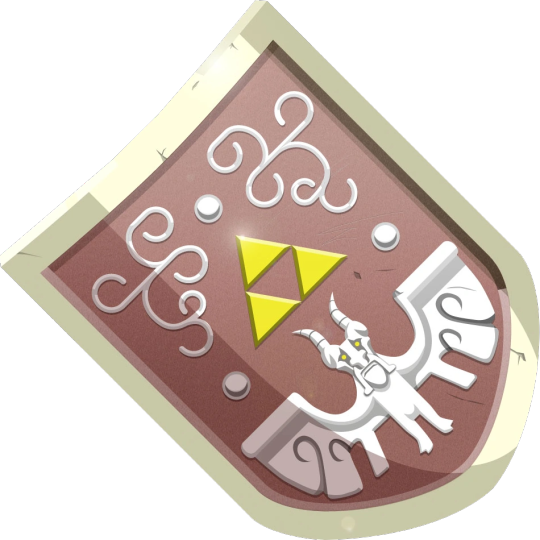
(Note: while some believe, due to Jabun’s discussion with the King of Red Lions, that the Hero of Winds is unrelated to the Hero of Time and thus he would not be a member of the Knight’s Family by default, this is an incorrect interpretation of the source text. What the King of Red Lions says in response to Jabun asking if he had located the Hero of Time is this:
私が連れている この者は 伝説とは 無縁の者です ですが、この者の持つ勇気に 私は、可能性を感じました
The one I have brought with me is not a part of the legend, but I can feel potential in the courage he possesses.
King of Red Lions (Wind Waker) - Translated by Sidier
The exact term used for “part” is 部分, which means part, portion or section. Basically, the King of Red Lions is not commenting on Link’s lineage at all - he’s saying to Jabun, no, the individual I have with me has nothing to do with the legend of the Hero of Time and is a different person entirely. The interpretation that he is unrelated by blood to the Hero of Time is inaccurate and brought about due to localization flaws and a lack of insight of the series in regards to Link’s family.)
The next overt reference to the Knights of Hyrule is when Link pulls the Master Sword. As soon as he does, a group of knight statues that surround Link lower their swords around him, as if “knighting” him in a ceremony. These statues were likely created to recognize the person who pulls the sword, the Hero, as a member of the Knights of Hyrule, and to show his or her connection to them.
The Knights of Hyrule are also mentioned by name later in the game by the King of Red Lions, who describes their failed assault on Ganon:
ガノン城は 昔・・・ 勇猛果敢な ハイラルの騎士団でさえ 落とせなかった 難攻不落の城だ ガノンの幻影に惑わされぬよう 感覚を研ぎ澄ますのだ
Ganon's Castle was once an impregnable castle that even the valiant Knights of Hyrule could not topple... so steel your senses and do not be deceived by Ganon's illusions.
King of Red Lions (Wind Waker) - Translated by Sidier
The Japanese term for Knight of Hyrule (ハイラルの騎士団) utilized by the King of Red Lions is slightly different than the term used in Oracle of Seasons, and actually incorporates the the term from A Link to the Past’s manual, Order of Knights (騎士団), but the two terms are still referring to the same thing.

The most important connection to the Knight’s Family present in The Wind Waker is in the form of the Knight’s Crest, or in the Japanese release, the Swordsman’s Emblem (剣士の紋章), is a type of collectible treasure that can be acquired from either defeating Darknuts, who wear it around their waists, or stealing it from them via the Grappling Hook. Orca from Outset Island has this to say about them:
剣士の紋章、それは力だけでなく 知恵、そして勇気をかねそなえた者のみが 集めることのできる 剣士の証 そして、それらを 10個 集めることができた者のみが、 一撃必殺の剣の技をおぼえる力を持つという
The Swordsman’s Emblem - a mark of a swordsman that can only be collected by those who possess not only power but also wisdom and courage. Only those who can collect ten of them have the ability to learn a sword technique that can kill with a single blow.
Orca (The Wind Waker) - Translated by Sidier
Upon collecting ten of these crests and bringing them back to Orca, Link learns the special sword technique that Orca mentions. Upon performing this technique, Orca says this:
リンクおお、それがまことの大回転斬りか?! ワシら兄弟の長年の夢を よくかなえてくれた!
Link! Oh! Is that the real Great Spinning Slash? You have fulfilled the long-held dream of my brother and I!
Orca (The Wind Waker) - Translated by Sidier
The technique Link performs is the Hurricane Spin, or, in the Japanese release, the Great Spinning Slash (大回転斬り). This is the same technique that was passed down by the Bumpkin family in A Link to the Past and learnt by Link after completing the Hero’s Trial in Four Swords Anniversary Edition. This draws a connection between the Knights of Hyrule and the The Wind Waker incarnation of the Darknuts. Darknuts have appeared in the series since the very first entry, but in this entry, due to possessing the Knight’s Crests, which Link uses to perform the Hurricane Spin, these Darknuts are connected to the Knights of Hyrule and their techniques – in fact, if Link performs the Hurricane Spin in the presence of a Darknut, they will perform it alongside Link, showing that they are capable of demonstrating a technique of the Knights of Hyrule.

While no direct conclusions can be drawn from The Wind Waker alone, this heavily implies that the Darknuts - at least as depicted in the Wind Waker - were Knights of Hyrule that were corrupted or transformed, somehow, and the Knight’s Crests that they bear are capable of passing on their techniques.
The connection of the Knights of Hyrule to Darknuts as well as the Knight’s Crests will be greatly expanded upon in the next game to be discussed, Four Swords Adventures.
Four Swords Adventures
In Four Swords Adventures, we get our most expansive appearance of the Knights of Hyrule to date. In the game, we encounter several Knights of Hyrule - or rather, what’s left of them.
The Knights of Hyrule are first brought up after saving the Green Maiden at the Tower of Flames, where she compares the bravery of the four Links to the Knights of Hyrule.
この炎の中を あなたは…。 …その勇気、まるでハイラル騎士団(きしだん)のようですわ!…ハイラル騎士団…!彼らは ゆうかんで忠実、使命のためには 命をもおしまないハイラル王国の ほこりです。このハイラルには天空への道を開く神器、4つの宝玉があります。ハイラル王家は 宝玉を守る役目を、しんらい厚い 騎士団に代々 あたえてきました。しかし その彼らがこのハイラルの危機にすがたを見せないなんて…。いったい 何が…?
You made it through the flames!…. …your courage is just like that of the Knights of Hyrule! The Knights of Hyrule…! They are the pride of the Kingdom of Hyrule, eager, loyal, and willing to die for their mission. In Hyrule, there are four treasures, sacred artifacts that open the way to the sky. The Royal Family of Hyrule has given the role of guarding the treasures to the highly trusted Order of Knights for generations. But how could they not show themselves in the face of Hyrule's crisis? What in the world is happening…?
Green Maiden (Four Swords Adventures) - Translated by Sidier
In this dialogue, we learn a lot about the Knights of Hyrule in this era. For starters, they’re the “pride of the Kingdom of Hyrule,” and they guard the four Royal Jewels, which when united allow an individual to access the Tower of Winds and by extension the Realm of the Heavens. When describing the Knights of Hyrule, she uses two terms - one is the same term from Wind Waker that the King of Red Lions used, and the other is just Order of Knights (騎士団) standalone, which hasn’t been used in this manner since A Link to the Past’s manual. This is likely due to the intimate story connections that Four Swords Adventures has to A Link to the Past.

As the game continues, we learn of the unfortunate fates of the Knights of Hyrule who protected the four Royal Jewels. The Red Knight puts it like this:
赤き宝玉を まもりし騎士。勇者よ聞け、騎士のなげきを。我々ハイラル騎士団は、強大な武器を持った男に倒され、宝玉とともに 魔界へと落とされた。その後すぐ 黒き影達により、我々と宝玉は 各地に散らされ天空の塔は すがたを消してしまった。
I am the Knight who guarded the Red Jewel. Hear, O heroes, the knight's cry. We, the Knights of Hyrule, were defeated by a man with a mighty weapon, and cast into the demon world together with the jewels. Soon after, the black shadows dispersed us and the jewel to various places, and the tower of the sky disappeared.
Red Knight (Four Swords Adventures) - Translated by Sidier
In summary, Ganon encountered them, and, using the evil magic of the Trident, turned them into demons, and then turned the Royal Jewels into portals to the Dark World. The Links slay them in combat, freeing them of their torment. The Links are then tasked with saving the Princess Zelda along with the rest of Hyrule by the spirits of the Knights before they pass on. However, they aren’t the only example of possessed Knights of Hyrule in the game. The Links also encounter multiple knight enemies throughout the game, and, when comparing their appearances and even their manner of fighting to those of the corrupted Knights of Hyrule, we quickly realize these knight enemies are also corrupted Knights of Hyrule.
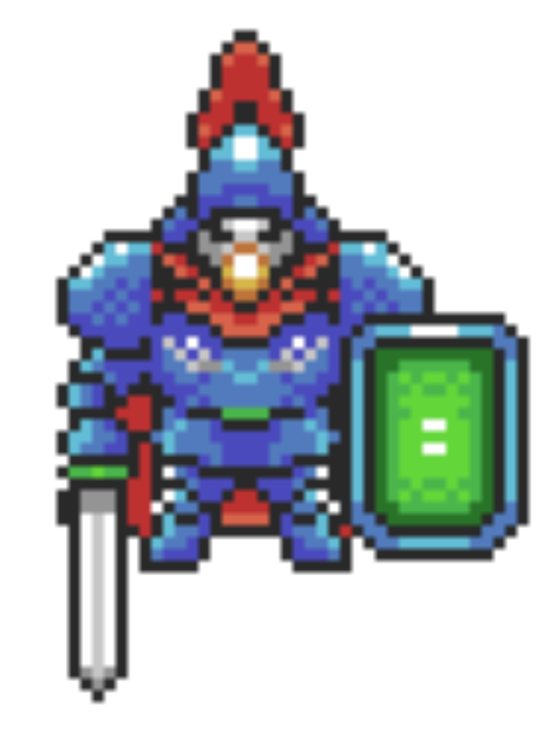
Most interesting, however, is the name that is provided to these knight enemies in the The Legend of Zelda: Four Swords + - Official Nintendo Guidebook (ゼルダの伝説4つの剣+―任天堂公式ガイドブック). In it, the first encounter with one of these enemies is described in the book as follows:
では青のタートナックと多数の兵士が出現。タートナックは手強いので、先に兵士を倒し、1対1の状況に持ちこもう。全滅させると大量のフォースが降り、先へ進めるようになる。
In the first section, a blue Tartnac and many soldiers appear. The Tartnac is tough, so you must defeat the soldiers first and bring the game to a one-on-one situation. If all the soldiers are killed, a large amount of Force will descend and you will be able to proceed.
Shogakukan Guidebook - Translated by Sidier
These enemies are called Tartnacs (タートナック), which is the Japanese name for Darknut. This means that Four Swords Adventures explicitly confirms that Darknuts - at least in their modern incarnation - are corrupted Knights of Hyrule, as heavily implied in The Wind Waker, explaining their usage of a sword technique that is passed down amongst the Knights of Hyrule.
(Note: Again, while I am hesitant to use guidebooks, they can be considered a sort of necessary evil when it comes to learning the names of enemies present in video games, as sometimes these games simply do not elaborate on the names of enemies. Also, when analyzing the source in this instance - Shogakukan, the publishers of the book - have been privileged with the opportunity to read several Nintendo development documents and have interviewed several Nintendo staff members over the years, and thus have likely been given access to the names of enemies created during the development process. Further, when cross referencing the book with other sources such as the game and the official Four Swords Adventures Japanese website, the names that are present are consistent across all three. Therefore, I believe it’s reasonable to use the guidebook in this instance.)
We also see the return of the Knight’s Crest from The Wind Waker. While the belt itself doesn’t make an appearance, the symbol on it appears several times. The first time we see it is at the beginning of the game, though it is slightly obscured. It’s present in the chamber of Hyrule Castle that allows for access to the Four Sword Sanctuary, and then in the Four Sword Sanctuary itself.
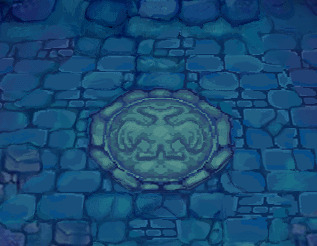
This is significant, as we learn in the introduction that the Four Sword was once utilized in the past by a Hero who used it to seal away Vaati, or, in the Japanese release, Gufū (グフー):
その昔 ハイラルという国にグフーという風の魔神があらわれ美しい娘を次々とさらっていきました人々が困り果てているとそこへ一本の剣をたずさえた旅の勇者があらわれました勇者が剣をぬくと体が4つに分かれ力を合わせてグフーを退治したといいますその後 勇者がグフーを封印(ふういん)した剣はフォーソードと名付けられハイラルの奥地 聖域(せいいき)にひっそりと まつられていました
A long time ago, in a country called Hyrule, a wind demon called Gufū appeared and kidnapped beautiful girls one after another. When the people were in trouble, a traveling Hero appeared carrying a sword. When the Hero drew his sword, It is said that his body was divided into four and they combined their powers to exterminate Gufū. Afterwards, the sword with which the Hero sealed Gufū was named the Four Sword, and it was quietly enshrined in a sacred area in the depths of Hyrule.
Introduction (Four Swords Adventures) - Translated by Sidier
The symbol is also present on the map of Hyrule, as seen in the credits. This would make sense with the knowledge of the Green Maiden calling the Knights of Hyrule the “pride of Hyrule” - their symbol adorns the map of Hyrule because of the value they hold to the kingdom due to being Hyrule’s sworn protectors and the family of the Hero.

Finally, their symbol appears in the Palace of Darkness, above where the Dark Mirror was once enshrined. To understand the significance of this, it’s important to know exactly what the Dark Mirror is and its involvement in the history of Hyrule. We learn this from the White Maiden, after rescuing her at Hyrule Castle:
それに森の奥深くにある神殿。そこには闇の鏡がまつられています。はるか昔 闇の一族がハイラルに せめこんだ時、その者らを 鏡の中に閉じこめました。そして、闇の一族と あの鏡がこの世界と 関わりを持たぬようその神殿へ かくしたのです。心悪しき者の手へと、闇の鏡が わたるような事は、決して あってはなりません。
There’s also a temple deep in the forest. The Dark Mirror is enshrined there. A long time ago, when a Dark Clan invaded Hyrule, they were trapped inside a mirror. Then, to avoid the Dark Clan and that mirror from interfering with our world, they were hidden in that temple. The dark mirror should never fall into the hands of someone with an evil heart.
White Maiden (Four Swords Adventures) - Translated by Sidier
The last small connection to the Knights of Hyrule in Four Swords Adventures is the return of the Hurricane Spin from A Link to the Past, Four Swords Anniversary Edition, and The Wind Waker. The sword technique has a slightly different name in the Japanese version this time, around, however - instead of Great Spinning Slash (大回転斬り), it’s more accurately read as the Super Spinning Slash (超回転斬り), but otherwise it is identical to the technique from the previous games.
The Minish Cap
A minor aspect of The Minish Cap’s connection to the Knights of Hyrule is the reappearance of The Wind Waker aesthetic of Darknuts, who, as we’ve established alongside their appearance in Four Swords Adventures, are corrupted Knights of Hyrule.
More importantly, however, is the Blade family. The Blade family is first introduced to us in Hyrule Town in the form of Swiftblade, the second eldest sibling in the Blade family.

He teaches a dojo on swordplay, and all of his siblings, whenever Link finds them, will also teach Link new sword techniques and abilities. The first technique Link learns from Swiftblade is one that has been present several times in the series before: the Spin Attack, or the Spinning Slash (回転斬り).
秘伝 回転斬りを おぼえた!テッシン ししょうから 数わった さいしょの剣技だ!
I learned the secret art, the Spinning Slash! This is the first art that Master Tesshin taught me!
Flavor Text (The Minish Cap) - Translated by Sidier
As we know, the Spin Attack is a technique closely associated with the Knights of Hyrule, as it is passed down closely within their families, thus associating the Blade Family with the Knights of Hyrule due to their passing down of this technique. Over the course of the game, Link encounters the other Blade siblings and learns the other secret arts, which are recorded via collectible scrolls called Tiger Scrolls. Swiftblade I, whose ghost can be found in Castor Wilds, teaches us the final secret art which is passed down through the Tiger Scroll. The ultimate sword art of the game, similar to previous entries and subsequent entries, is none other than what this game dubs the Great Spin Attack, or, in the Japanese, the Great Spinning Slash (大回転斬り).
秘伝 大回転斬りを おぼえた! これぞ キュウキョクの 剣技なり!!
You learned the secret art, the Great Spinning Slash! This is the ultimate art!
Flavor Text (The Minish Cap) - Translated by Sidier
As we’ve established thus far, the Knights of Hyrule are demonstrably connected with certain sword techniques such as the Hurricane Spin/Great Spin Attack, so this makes it likely that the passing down of these techniques establishes the Blade Family as Knights of Hyrule.
Something to keep in mind for later is also the technique taught by Grimblade. Upon learning his technique, this is the flavor text we are given:
秘伝 剣ビームを おぼえた!剣の先から ビビッと ビーム!!ライフが まんたんの時しか 使えない
I have learned the secret of the Sword Beam! The sword beam comes from the tip of the sword! I can only use this when I am at full life.
Flavor Text (The Minish Cap) - Translated by Sidier
We learn from this text that the Sword Beam (剣ビーム), a technique originating from the very first entry in the series, is also a technique that can be taught and passed down via those who possess the blood of the Knights of Hyrule, as it is passed down via the Blade Family to Link, and as we know, the Blade Family knowing how to perform and being able to teach the Hurricane Spin/Great Spin Attack establishes they are also Knights of Hyrule.
Twilight Princess
Twilight Princess has two topics relevant to the Knights of Hyrule: the Hero’s Spirit and the return of Darknuts.
The Hero’s Spirit, also known as the Hero’s Shade, is an enigmatic specter who takes either the form of a golden, shimmering wolf, or a skeletal warrior donned in ruined armor.
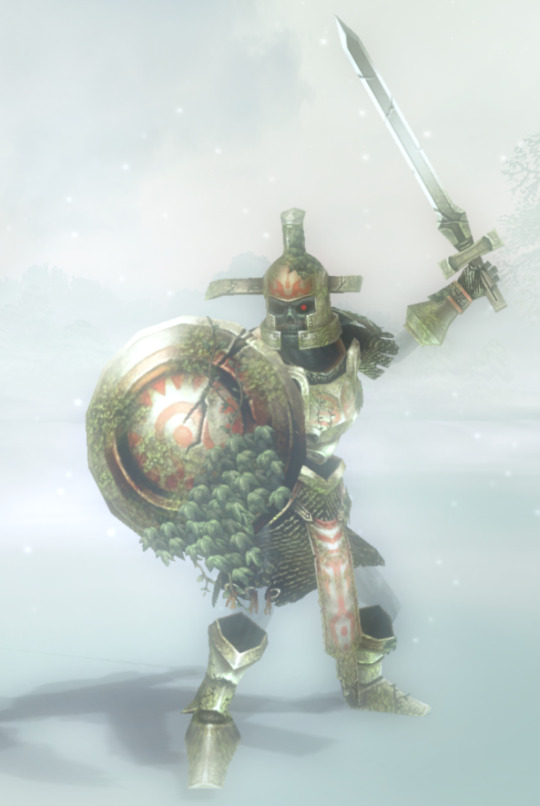
When we encounter him, he teaches us seven secret sword arts called the Hidden Skills, or, in the Japanese release, what he refers to as Secrets (奥義). After learning the second Hidden Skill, he tells Link the following:
お前に伝えるべき奥義はまだ5つある だがそれは、気高き獣の精神を備える勇者の血族だけに受け継がれるもの
I still have five more secrets to tell you. However, they can only be inherited by the blood relatives of the Hero who possesses the spirit of a noble beast.
Hero’s Spirit (Twilight Princess) - Translated by Sidier
This tells us a few things. First, the Hero’s Spirit having secret sword techniques that can only be passed down by the blood relatives of the Hero, ergo the Knights of Hyrule, reaffirms what we’ve already seen before such as with the Spin Attack and the Hurricane Spin being passed down through the Knight’s Family. Second, it also reaffirms that Link is of the Knight’s Family while also revealing to us that the Hero’s Spirit is a member of the Knight’s Family, as he is the one who is teaching the techniques in the first place.
After teaching Link the technique, the Hero’s Spirit says the following before departing:
ついに、全ての奥義を手にしたな 勇者として生をうけながら後世にそれを伝えることの出来なかった我が無念も、ようやく晴らすことが出来た必ずや、幾多の戦いを経て なお、曇りなき眼で未来を見据えるそなたならこのハイラルを在りし日の神々が愛でた大地に戻すことが出来るだろう・・・さらばだ!怯まずに進め、我が子よ!
At last, you've mastered all of the Secrets! Though I was destined to be the Hero, I could not pass those lessons on to future generations. I at last was able to ease my regrets. After many battles, you can still look to the future with unclouded eyes. Surely you can restore Hyrule to the land that the gods loved in its days of yore. Farewell! Go forth without fear, my child!
Hero’s Spirit (Twilight Princess) - Translated by Sidier
With this, the pieces fall into place on who this specter is. The Hero’s Spirit was once a Hero who developed and formalized seven sword skills into techniques learnable by only blood relatives of the Hero. He wasn’t able to pass these techniques on in life, and, in death, had finally eased his burdens by teaching them to Link.
This reaffirms what we’ve already seen several times thus far - the Hero is born out of the Knights of Hyrule, who possess sword techniques that are passed down through their lineage.
Another connection to be made is through Twilight Princess’s Darknuts. While they don’t perform any sword techniques exclusive to the Knights of Hyrule in this game, there is a small but significant connection that is present on their armor - in the most apparent spot, their shield. Upon flipping the crest that is present on the shields of Darknuts upside down, it can be observed that it’s actually a variation on the symbol of the Knight’s Crest.


This associates the Darknuts of Twilight Princess with the Darknuts of The Wind Waker as well as the techniques of the Knights of Hyrule, and the appearance of the Knights of Hyrule of Four Swords Adventures, another example of the very solid and continuous throughlines when discussing the Knights of Hyrule.
Phantom Hourglass
Phantom Hourglass has very minimal Knights of Hyrule connections; in fact, there’s only one of significance, which is the reappearance of what this game refers to as the Great Spin Attack, or, as has been mentioned several times now, the Great Spinning Slash (大回転斬り). Following a long trading questline, Link receives an item called the Swordsman’s Scroll, which allows him to perform the technique.
剣士の巻物を手に入れた!巻物に 秘められた剣士の記憶が流れ込む・・・リンクは大回転斬りを使えるようになった!回転斬りと同じようにすばやく3回転させれば使うことができる!
You got the Swordsman's Scroll! The memories of the Swordsman hidden in the scroll are flowing in---Link can now use the Great Spinning Slash! You can use it by quickly spinning 3 times, just like the Spinning Slash!
Flavor Text (Phantom Hourglass) - Translated by Sidier
It’s important to point out that the Japanese name for Swordsman (剣士) in the name of the Swordsman’s Scroll is identical to the term used in the Japanese name of the Knight’s Crest, or the Swordsman’s Emblem (剣士の紋章). Both of these items are utilized to teach Link how to perform the ultimate sword technique, and both share the same term.
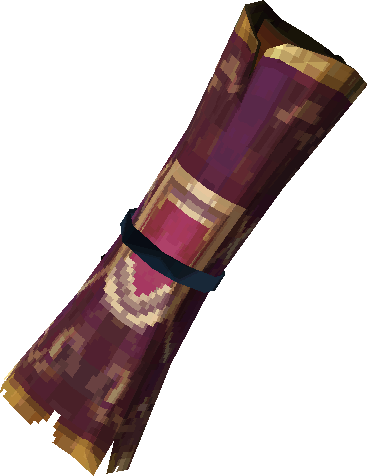
As we have learned from Twilight Princess, only Knights of Hyrule may perform the technique, so we can assume that the Swordsman’s Scroll was handed down from a Knight of Hyrule. As the text alludes, the memories of the Knight - likely the lessons that he or she has learned - are flowing into Link, allowing him to learn the ability of the ultimate sword art. It’s likely that this is similar to how the Knight’s Crests work, but to a greater degree, given how collecting 10 of them allows Link to perform the technique.
Spirit Tracks
Similarly to Phantom Hourglass, the Swordsman’s Scroll makes an appearance. This time it’s acquired from Niko, the Hero of Winds’ longtime friend and fellow member of Tetra’s crew. After acquiring all 20 stamps, Niko has this to say to Link:
あぁそうだね... ご褒美をあげないといかんかったの・・・ほれ これはどうだい!?それも昔の友人からもらったものでのお··· [...] なんでも自分の周りに すばやく 3回 円を描くと 大回転斬りとかいうものが 出せるそうなんだよ···
Oh, yeah... I have to give you a reward... how about this? It's a gift from an old friend. [...] If you draw a circle around yourself 3 times quickly, you can perform the Great Spinning Slash.
Niko (Spirit Tracks) - Translated by Sidier
Niko affirms that not only is he in possession of the Swordsman’s Scroll, but it’s the same scroll that once belonged to the Hero of Winds himself that he acquired in the events of Phantom Hourglass. Upon acquiring the scroll, this is what the flavor text has to say:
剣士の巻物その2を手に入れた! 巻物に秘められた剣士の記憶が流れ込む···リンクは大回転斬りを使えるようになった!回転斬りと同じように すばやく3回円を描けば 繰り出すことができる!
You got the Swordsman's Scroll #2! The memories of the Swordsman hidden in the scroll are flowing in---Link can now use the Great Spinning Slash! Just like the Spinning Slash, you can perform the Great Spinning Slash by quickly drawing a circle around yourself 3 times!
Flavor Text (Spirit Tracks) - Translated by Sidier
As the flavor text alludes, there are actually two separate Swordsman’s Scrolls in this game. The other is acquired at Rabbitland Rescue, a station in the Forest Realm. After catching 50 rabbits in the wild and returning them here, the owner of the rescue, Bunnio, will give Link the first Swordsman’s Scroll, which has the following text accompanying it:
剣士の巻物その1を手に入れた! 巻物に秘められた剣士の記憶が流れ込む・・・リンク よ剣から衝撃波を 出せるようになった! 剣を振るだけで 衝撃波がほとばしる!
You got the Swordsman's Scroll #1! The memories of the Swordsman hidden in the scroll are flowing in---Link can now emit a shockwave from his sword! Just swing the sword and the shockwave shoots out!
Flavor Text (Spirit Tracks) - Translated by Sidier
With this, we now have another technique that’s being passed down via an artifact likely associated with the Knights of Hyrule - the Sword Beam, which this text refers to as a Shockwave (衝撃波を). This coincides with what we learned from The Minish Cap, where the Blade Family teaches Link how to perform the Sword Beam, meaning that the Sword Beam, while likely not exclusive to them, is also a technique of the Knights of Hyrule.
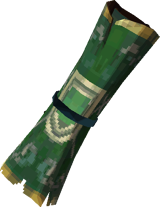
Skyward Sword
Skyward Sword sheds significant context on the Knights of Hyrule - or, at least, their origin, and their association with the Hylian Shield.
Up to this point, we’ve learned that the Hylian Shield is a shield used by the Knights of Hyrule, as established in Ocarina of Time, and appears again in Twilight Princess. There was also a smaller, personalized form of the Hylian Shield made - the Hero’s Shield - for the young Hero of Time before the events of Majora’s Mask occurred. Link's Awakening was also retconned in the Nintendo Switch remake to have the Hylian Shield, as well.

The Hylian Shield in this entry is described as an indestructible shield by the Thunder Dragon, Lanayru, and he is correct - the shield is completely invulnerable to damage and cannot be broken, unlike any of the other shields in the game. As this is the first appearance of the Hylian Shield in the timeline, a designer of the game, Manubu Hiraoka, comments on the significance of the shield and the emblem displayed on it.
たて赤い鳥に乗った勇者が後にハイラルとなる大地を救ったことから、盾には鳥が描かれています。 でも、 図柄はその前から描かれているので、 運命はすでに決まっていたのでしょう。
The shield has a bird on it because a Hero riding a red bird saved the land that later became Hyrule. But the pattern was created even before that, so his fate must have already been preordained.
Hiraoka (Designer) (Hyrule Historia pg. 9) - Translated by Sidier
Interestingly enough, Hiraoka points out very clearly that the shield has a red bird pattern on it because of Link’s role in Skyward Sword - he rides a red bird, the Crimson Loftwing, and therefore his shield is emblazoned with the Crimson Loftwing so as to represent him.

With this context, we can then look back at the entire series and understand why the Knights of Hyrule are so connected to the Hylian Shield. The Knights of Hyrule, the family of the Hero, bear the crest of the Hero who rode the Crimson Loftwing because that Hero would be their ancestor, and, given the context of Skyward Sword, also the person who we now know as the origin of their bloodline. While Skyward Sword alone cannot prove that Link in this entry is the progenitor of the Knight’s Family, a future entry will do that work for us.
(Note: I am deliberately ignoring the manga associated with Hyrule Historia due to the many contradictions it has and the lack of direct involvement from any member of Zelda team in the writing and production of the manga, as well as the book itself, which has several gaping errors and contradictions which break the foundation of the series and the games within it.)
Before moving on, I would like to discuss a possible counterargument that could be raised against certain assertions I’ve made thus far - namely about certain techniques being tied to the Knights of Hyrule.
In Skyloft’s Knight Academy, the instructor of the Sparring Hall, Eagus, teaches sword techniques to the students of the academy. Two of these techniques are sword arts that have been associated with the Knights of Hyrule - the Spin Attack, the Ending Blow, in this game titled the Fatal Blow, or the Finishing Blow (とどめ), as it is referred to in both the Japanese versions of Twilight Princess and Skyward Sword, and the Shield Attack, in this game titled the Shield Bash, or the Shield Attack (盾たてアタック) as it is referred to in both the Japanese versions of Twilight Princess and Skyward Sword. Eagus mentions these names by technique several times, as seen here:
敵が攻撃してくるのに合わせて盾を構えると その勢いで敵の攻撃をはじき返すことができる盾アタックと呼ぶこの技を使えば敵をひるませて 攻撃のスキを作ることができるのだ [...] 丸太の中心に立って動かずに タイミングよく 剣を振らねば回転斬りは 出ないぞ もう一度やってみるか [...] とどめは 盾や回転斬りがきまって敵が吹っ飛んで ダウンした時に有効となる 技だからな
If you hold your shield in time with the enemy's attack, you can use the momentum of your shield to repel the enemy's attack. This technique, called a shield attack, allows the enemy to flinch, creating a gap for you to attack. [...] You must stand in the center of the log and swing your sword at the right moment without moving or you won't be able to perform a Spinning Slash. [...] The "Finishing Blow" is a technique that is effective when the enemy is knocked back or downed by a Shield Attack or a Spinning Slash.
Eagus (Skyward Sword) - Translated by Sidier
As Skyward Sword takes place before the establishment of the Knights of Hyrule, due to the implication of Link in this entry being their progenitor, this could cause a potential contradiction with previous entries that suggest these techniques are associated with the Knights of Hyrule. To quickly debunk this notion in relation to the Fatal Blow and Shield Bash, the Skyward Sword incarnations of the Ending Blow and shield Attack from Twilight Princess, it’s important to look at the context of what the Hero’s Spirit says after learning both of these techniques:
お前に伝えるべき奥義はまだ5つある だがそれは、気高き獣の精神を備える勇者の血族だけに受け継がれるもの
I still have five more secrets to tell you. However, they can only be inherited by the blood relatives of the Hero who possesses the spirit of a noble beast.
Hero’s Spirit (Twilight Princess) - Translated by Sidier
He establishes that the techniques Link learns after the Ending Blow and Shield Attack can only be inherited by blood relatives of the Hero. This means that the Ending Blow and the Shield Attack are not, in fact, exclusive to the Knights of Hyrule, and can likely be performed by anybody who would want to learn them.
The Spin Attack can be explained best by pointing out the mechanics of the Spin Attack when it is explained to Link. For example, reusing what Link’s uncle says in A Link to the Past:
ナイトの一族に伝わる剣の秘術 お前に... さずけよう。 よくきけ...Bボタンを押し続け 剣に力をためる. ボタンをはな した時、その力が現れる.
The secret of the sword, passed down through the line of knights... I will teach you. Listen carefully. Hold down the B button. When you release the button, the power will be released.
Link’s Uncle (A Link to the Past GBA) - Translated by Sidier
Here, we see that the important part in performing the Spin Attack is focusing power in the blade, and then releasing that charged up power. This is a consistency throughout the series, including games like Link’s Awakening and Ocarina of Time.
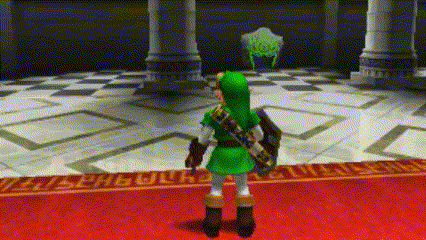
The technique Link performs and Eagus teaches in Skyward Sword does not involve focusing energy in the blade - in fact, Eagus never even mentions it, only saying to swing the sword at the right time to perform the technique, as shown in the text provided above. This is very important, as Ocarina of Time, as previously mentioned, actually provides a proper distinctive name for a sudden Spin Attack with no charge:
秘技 回転斬りを おぼえた!!Βを押して 気合いを ためる Βをはなすと 回転ビーム!気合いを ためずに やりたい時はCを一回転させ Βで OK!クイック回転で 効果バツグン!
I have learned the secret technique of the Spinning Slash! Press Β to build up energy. Release Β for a spinning beam! If I want to do it without building up my energy, Rotate [the Control Stick] once and press Β to perform it. The Quick Spin is very effective!
Flavor Text (Ocarina of Time) - Translated by Sidier
This text reveals to us that there is a distinction between a charged Spin Attack and an uncharged Spin Attack, which it refers to as a Quick Spin (クイック回転). The Quick Spin involves the performer quickly rotating while swinging their sword without charging energy in their blade.
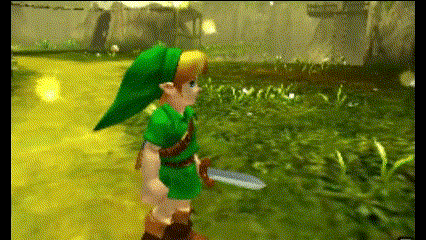
This perfectly describes the way Spin Attacks are performed in Skyward Sword, and thus explains why the Skyloft Knight Academy teaches how to perform the Spin Attack before the Knights of Hyrule exist - it’s not a true “Spin Attack” in the sense of charging their blade with energy, an important part of the technique as performed by the Knights of Hyrule. Instead, Link performs a Quick Spin, which, as described in Ocarina of Time, entails the performer specifically not charging their blade with energy.
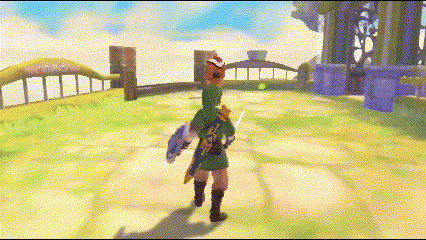
Therefore, the techniques performed by Eagus and learnt at the Sparring Hall do not contradict that notion that specific sword skills such as the charged Spin Attack are exclusive to the Knights of Hyrule, because the techniques as we see them in Skyward Sword are not ones that are associated with the knights in the first place.
A Link Between Worlds
The Hylian Shield makes another appearance in this entry, depicted almost identically to its Skyward Sword incarnation. The appearance of the shield in this entry again reaffirms the connection the Hero has to the shield, especially after the revelations of Skyward Sword, and thus to the connection the shield has to the Knights of Hyrule as a whole.
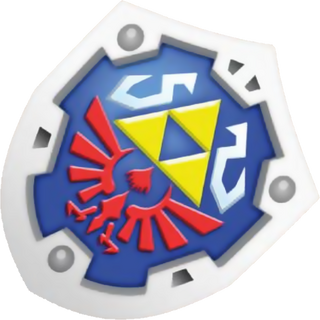
The Hurricane Spin/Great Spin Attack/Great Spin also reappears, this time utilizing the form it took in in Twilight Princess as a significantly larger Spin Attack. It is acquired by Link after being enhanced by Mother Maiamai upon saving all 100 of her children. Mother Maiamai throughout the game will upgrade Link’s gear by sucking it in her mouth and presumably upgrading it inside of her somehow.

Upon returning all of her children to her, she says the following:
ミーのジュニアたち、みんな見つかりました!ホントにサンクス!コレはサンクスの気持ちデす
All of my juniors have been found! Thank you so much! This is a special THANK YOU!
Mother Maiamai (A Link Between Worlds) - Translated by Sidier
After saying this, she then sucks Link into her mouth. She spits him out, and upon doing so, we immediately get the following text:
大回転斬りをマスターした! Bを押して気合をタメて放とう!
I have now mastered the Great Spinning Slash! Press "B" to build up power and release it!
Flavor Text (A Link Between Worlds) - Translated by Sidier
Since Mother Maiamai upgraded Link’s items whenever she swallowed them and spat them out, her swallowing and spitting out Link means that she “upgraded” him. Upon being “upgraded,” Link then expresses that he has acquired mastery over the Great Spinning Slash (大回転斬り), the technique we’ve seen across several entries in the series. This shows that it is also possible to learn the ultimate sword art without formally being taught it or having items that allow access to it such as the Swordsman’s Scrolls from Phantom Hourglass and Spirit Tracks, which suggests that it is an innate technique to the bloodline of the Knights of Hyrule that can be accessed through multiple means.
This harkens back to The Wind Waker, where, when Link performs a parry, he can perform three Hidden Skills, the techniques from Twilight Princess, without ever being directly taught them: the Ending Blow, the Back Sice, and the Helm Splitter. Similarly, this is akin to how some Links must be taught the Sword Beam, while others can naturally perform it.


With all of this information, we can reasonably assert the following: While the secret arts of the Knights of Hyrule that are passed down typically require being learnt from a teacher or an item, it is possible that they can be performed without requiring a teacher or an item due to the innate connection these techniques have with the Knights of Hyrule. This explains why these secret arts appear so often - they are innately tied to the bloodline of the Knights of Hyrule - and why, in Twilight Princess, the Hero’s Spirit established that only those who are blood relatives of the Hero can perform them - their innateness to the Knights of Hyrule is what allows them to be learnable only to them in the first place.
Click HERE for Part 2 of this article!
#zelda#legend of zelda#zelda lore#zelda theory#nintendo#hyrule#knights of hyrule#the legend of zelda
9 notes
·
View notes
Text
Cradle Analysis: Scripting vs. Other Stuff
There will be spoilers up through…Wintersteel, to be safe. I'll avoid major plot spoilers; this post will be more about general character information and interactions that happen up through this book.
So as far as "command over reality" goes, madra is almost straightforward. It's a themed energy like common fantasy "elemental magic" that can be shaped to produce great effects. Scripts are a little more nebulous, because it seems like they are a rudimentary form of programming on the world. And there are a lot of ways they can be used, so I'll get into it.
Scripting is present since the first chapter, and it actually takes up a sizeable chunk of space for something that's usually not related to the story. But seeing Lindon use "rudimentary" scripts and plenty of organizations using scripts as part of their security or utilities, it helps the world feel grounded in its magic system. Now, in a different fantasy book, scripts would take the form of enchantments in most cases, and in real life is the equivalent of using the Command Prompt on a computer. It's sometimes really powerful, but can technically be done by anyone with a little know-how. Mainly the only reason I use that analogy is to say that Lindon is a guy who sometimes programs and is fluent in navigating Windows 98, and Ziel is a full-stack developer who can think in assembly. He knows his scripts.
I can't think of anything that scripting can't do, actually. It requires knowledge, time and precision to carve or write the scripts, and a material that can handle the level of madra that will be flowing through it. And it seems like it can't do any sort of sacred arts techniques -- but that seems more like a problem of inefficiency, and since bindings are plentiful people use those instead.
Soulfire is basically instant scripting, which lets those in the Lord realm use aura types that aren't on their Path. But, once again, they could use a binding for that, and soulfire requires natural treasures which can be hard to find. Soulfire also lets you juice up anything you could use madra for, so it's usually used to reinforce and supercharge ordinary techniques. But I'm listing it for completeness.
Then, we've got Sage commands. Those have the utility of soulfire, but instead of being limited by wealth or luck (to acquire natural treasures), they are limited by nebulous "willpower" which to me reads as mental stamina. Sage commands can also do way more powerful stuff than scripting, but they don't have the same overall breadth in ability.
I wish I could talk about scripting more, but I don't really know what to say. It takes up almost equal page space as anything else in Cradle's magic system than techniques (which take up the far majority), but I'm not an experienced enough theorycrafter to say much about it. It seems as self-consistent to me as English, which is to say, it's got its rules and it somewhat follows them, but I can only go off vibes to say what works and what doesn't.
21 notes
·
View notes
Text
What Guts is for Griffith
a dispassionate analysis written for a better understanding of both characters and of Berserk
Part 6: What is it he desires so much?

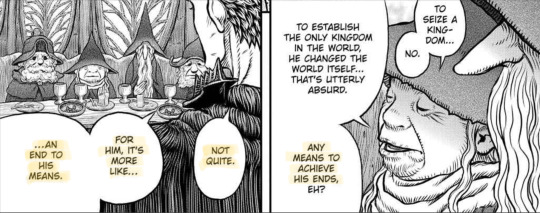
Not unlike the English word dream, 夢 (yume) refers both to those images we conjure in our sleep or to a wish we want to make happen. An older kanji expression for it, mostly discarded in favor of the new one, was 寝目, where the first character refers to sleeping and the second to eye (or eyes), making the concept of dream/dreams an equivalent to something like sleeping eyes.

A very well known aquatint by Spanish painter Francisco Goya, from the satirical series Los Caprichos published in 1799, is titled El sueño de la razón produce monstruos (The dream/sleep of reason produces monsters). The full epigraph reads: “Fantasy abandoned by reason produces impossible monsters: united with her [reason], she [fantasy] is the mother of the arts and the origin of their marvels”. In his illustration, Goya is portrayed having fallen asleep while drawing at his desk, all around him there are creatures associated with evil and folly. The satirical series Los Caprichos depicts human vices like greed, vanity, but also delusions and superstitions, in the context of the values promoted by the Enlightenment. Goya’s etchings and paintings are still well known today, especially for those people who love the arts or have investigated the irrational worlds and the superstitions of the pre-Enlightenment Europe. The epigraph, however, demonstrates how Goya’s message is more complicated, as he believed that human imagination shouldn’t be replaced by the strictly rational plane and that fantasy, if united with the reason, is the irreplaceable source for artistic minds. Goya’s works opened the door for many of the visual elements in dark fantasy tales. Kentarō Miura isn’t dissimilar, in Berserk logic and reason aren’t the real answers. Humanity, confronted with darkness, death, fear and despair, looked for a reason and failed, conjuring the idea of evil or the idea of a savior, the desired one, both fallacious delusions, fantastical beliefs that generated a nearly omnipotent power structure, that oppressed them even more and added to the caos. Griffith devoted his life to a dream, and in doing so he envisions a future through sleeping eyes. Griffith’s madness is showcased in some of his expressions, but often times in the Golden Age arc we are purposely shown how fundamentally human he is.

During the eclipse Void explains: “All lies within the currents of causality. Everything has been determined. All of your lives have been spun into this sacred point in time, the eclipse”. Once the altar for the sacrifice is formed, Ubik opens a portal to Griffith’s unconscious mind, his past memories relived through the logic of a sleeping/dreaming mind. He says to Griffith: “This is not an illusion. It is the reality within your conscious realm… materialized within this dimensional plane”. The words confirm that it isn’t indeed the conscious mind, the awake and rational one, because a special filter is applied to what Ubik conjures: Griffith’s memories are materialized within this dimensional plane, which isn’t reality, but a dream-like state, an in-between: “This is a weird place”. In this sequence, we are given a visual reference for the expression used by Void: “All of your lives have been spun into this sacred point in time”, as we can see an old lady while she is working yarn into a thread on a spinning wheel, like one of the Norns, or Moirai, would do on her spindle.

Griffith is made to relive certain memories and emotions, especially his guilt and fear, through his child self and with the assistance of the old crone, who has followed him to a pile of corpses: “What’s wrong? Are you afraid now? Do you want to turn back? You mustn’t think that way!” The old crone is now revealed as being both Conrad and Ubik. Following the story further, and especially through the double pages illustrations of the four Guardian Angels of Desire, after the great roar of the Astral World, we gain a better idea of their roles and their domains: Conrad being a manifestation of disease and Ubik of madness and illusion. Considering the physical and mental conditions of Griffith at the time of the Eclipse, Conrad and Ubik are the ones who have more power over him. Griffith’s mental anguish is displayed fully. The most instrumental memories, of the back alley boy playing a game, of the death of the unnamed child soldier and of Guts’s final words that dismissed Griffith’s insecurity, together with physical and mental torture are the instruments to guide him towards a precise choice.



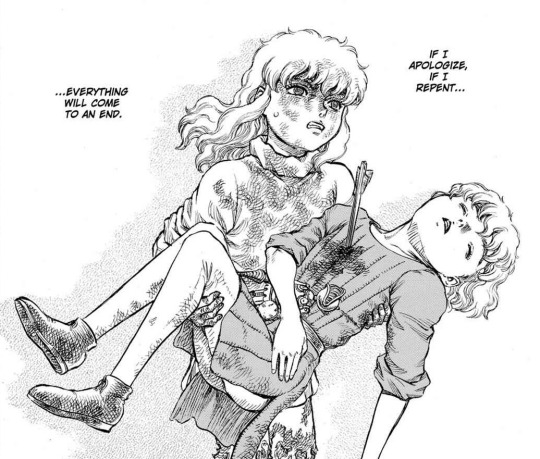
25 notes
·
View notes
Note
Gimme your theories about the Earthly Gods and Mugenri.
Alrighty then, it's not exactly a single, unified neat theory though, I must say. More of a disparaged collection of random ideas. In any case, here are some of my random thoughts(?)/theories(?) about Mugenri and the Earthly Gods.
Canonical Information #1
Hoojiro's Mysterious Line
This all started here, with this mysterious line said by Hoojiro which was not elaborated on at all:
AWTIF [Baclside] - Alice Leaping Atop Lily Pad Ice
Hoojiro "Have you ever heard of it? The story of the imperial family and the Earthly Gods buried by history's darkness."
Analysis
In Japanese mythology, the Shinto gods are divided into two factions: The Heavenly Gods (天津神) who live on Takamagahara (高天原), the Shinto celestial realm, and the Earthly Gods (国津神) which reside on the earth.
The earth (Japan) used to be ruled by the earthly gods, but the leader of the heavenly gods, the sun goddess Amaterasu-Ōkami (天照大神), declared one day earth should be ruled by one of her descendants instead.
She sent three waves of messengers to negotiate the handover of the earth to the heavenly gods. While the first two waves defected, the last wave of messengers, through both diplomacy and violence, successfully negotiated the"Transfer of the land" (国譲り).
With the sovereignty of the earth successfully obtained, Amaterasu sent her own grandson, Ninigi-no-Mikoto (瓊瓊杵尊), down to rule over the earth. There, he wed Konohanasakuyahime (木花之佐久夜毘売) and sired the ancestor of the Japanese imperial family.
These events are likely what "story of the imperial family and the Earthly Gods" refers to, although what spins Len'en will make to yet, if any, is yet unknown.
Canonical Information #2
Mugenri's Origin
We don't know much about Mugenri's origins, only that it was once continuous with the outside world but had been completely separated from it by the Mugenri Barrier. Additionally, we also know that this was done by the first Senri priest along with several others.
Another potential source for Mugenri's origin comes from Hoojiro:
AWTIF [Backside] - To Mugenri
Hoojiro "Another world..... A country of a race that split off from mankind long, long ago."
Haru "...The 'Country of Non-Humans'. The one that Tsubakura Enraku looked into in the past."
Analysis
Although she never calls it Mugenri by name, Tsubakura was looking into it prior to their disappearance in EE, and the theme of "non-humans" certainly seems in line with Mugenri.
EE Prologue
This country is a place where both humans and non-humans live together.
[...]
This is a story of humans and non-humans.
[...]
This is a land where limitless relations and illusionary laws are linked together.
People call the land "Mugenri".
Canonical Information #3
Alternate Titles for Mugenri
In addition to the potential "Country of Non-humans", Tom also gives a number of other titles that Mugenri is known by in BotC:
BotC: EE Yabusame 1-1
- The Gods' Tabooed Land
- The Garden of Eden
- The Lost Horizon
- The Oppressed Land of Exile
However, NiLU does add that it's likely not all of these names originally referred to Mugenri, but merely got conflated with it. Nevertheless, they may give us the clue as to Mugenri's nature.
Analysis
"Tabooed Land" (禁足地) is a concept in Shinto. Typically found within Shinto shrine grounds, they are sacred spaces that humans are prohibited from entering and are restricted to the gods only, said to be where they dwelled or descended from the heavens.
The Garden of Eden is a biblical paradise mentioned in Abrahamic religions, where the first humans Adam and Eve once lived before being exiled by God for eating the forbidden fruit from the tree of the knowledge of good and evil.
Lost Horizon is a 1933 novel by English writer James Hilton, famous for being the origin of Shangri-La, a fictional utopian lamasery.
Theories & Possibilities
Now that we have all the basics, we can go into some of the possibilities and theories that I have, keep in mind that most of these are pretty shaky, so definitely take them with a healthy pinch of salt.
Theory — On the origins of Mugenri
Considering Mugenri's titles as "The Gods' Tabooed Land" and "The Garden of Eden", it's possible that that's where a human-like original race (that Yago and Souko originally belonged to) first "emerged" or "descended".
It might have once used to be a fairly paradisiacal place, considering how it's the "Garden of Eden" and the "Lost Horizon".
As they continued to develop and spread across the world, this race split into humans and non-humans. Eventually, the non-humans returned to Mugenri, and eventually decided to isolate themself in this land using the Mugenri Barrier.
This would be how the Country of Non-Humans (which we're assuming is Mugenri) belongs to a race that split apart from humans long ago.
The reason they returned and secluded themselves in Mugenri could be potentially related to the heavenly gods wrestling control of the earth from the earthly gods.
Those who didn't wish to be subject to the heavenly gods' rule, and later the Japanese imperial family's, may have returned to Mugenri and finally separated the two locations entirely by putting Mugenri in a separate dimension.
Bonus Theory
In Shinto myth, rule over the world was divided among three children of the creator (although not primordial) god Izanagi (伊邪那岐).
The goddess Amaterasu got Takamagahara
The god Susanoo-no-Mikoto (須佐之男命) got the sea (although he would abandon his domain)
The genderless/male god Tsukuyomi-no-Mikoto (月読命) got the "Dominion of the Night"
Tsukuyomi, along with his domain, is poorly understood, in fact, they practically disappear from the myths after this. (Although one anecdote attributed to Susanoo is sometimes attributed to Tsukuyomi instead.)
In "Dominion of the Night", the word translated as "Dominion" is “osukuni” (食国), which is typically used to indicate the area which the Emperor has power over. It is suggested that it means that Tsukuyomi has dominion over the entire country of Japan during the night, and some believe it may even refer to the entire world.
I have absolutely no proof for this, but a mysterious genderless god whose realm is unknown seems almost perfect to be adopted into Len'en as Mugenri and the main god of the Senri Shrine.
Again, very likely nothing at all, but still fun to think about.
And that's all I have here, I give a 30% chance the main theory is true at all, and optimistically a 70% chance that some part of it is. In any case, I hope you enjoyed it :)
30 notes
·
View notes
Text
Sacred Realm updated! :D
New chapter new ramble here I am!
Sacred realm has returned with Chapter 4, named The hearald and the gorons, (Considering we start by climbing death mountain this brings me joy.
I'll get the important stuff done, This is done with permission from @zelda-the-sacred-realm, and all art from the comics belongs to the comic artist.
The link to the comic can be found here! Go give it some love it's expertly done! :D
Now, grab some popcorn and a drink, sit down someplace comfortable and have fun!
Lets go!

It absolutely must be said the backgrounds of this comic never cease to amaze me at how detailed they are. I low key almost feel as cold as it looks there. It's damn incredible.

Oh man i love him so much he's so sweet
He's just a curious little bab

Time really do be >:(

Name drop! :D Huzzah!
Link you innocent bean

Is that who i think it is?
checks notes
IT IS
Okay okay okay Time to do my research. I'll go into it more when we get through the panels with him in.

This is so sweet, Interesting that he knew Twi when he was alive. (Note the lack of fun yellow glow that the other spirits have)
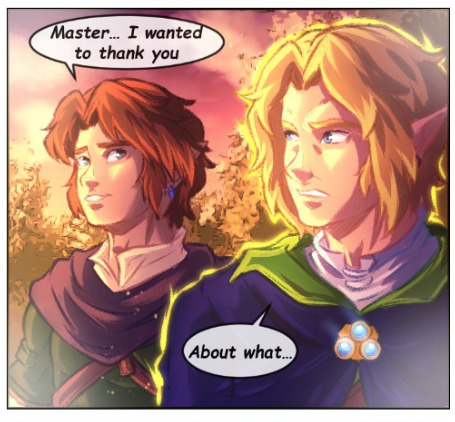
Calling him master. Considering what we know from twilight princess and the hero of time and the hero of twilight this makes a bunch of sense.

Oh he's so pretty
So from my understanding of Twilight's lore, He sees time as a mentor (Hence calling him master.) Twilight seems to be alive here, so i would say that this is either during his actual adventure or just after it, meaning that the area we see around them must be Twilight's time.
(Also Epona beloved)
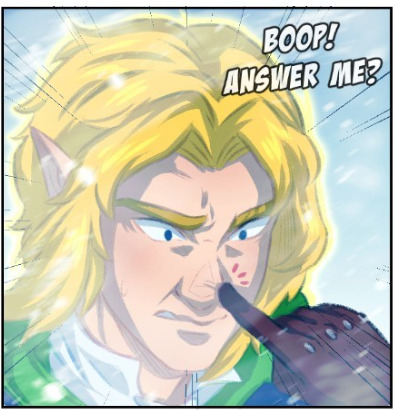
OH MY GOD HE DID IT THE HERO
WE GOT A TIME BOOP IN COMIC IT IS CANON NOW
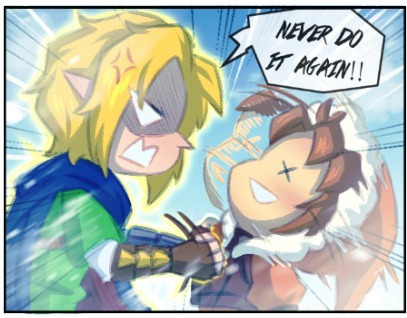
link will 100% do it again, maybe even Twilight will get involved.

Trying to decipher what Sky was saying here was fun, also Sky being protective of Link gives me life okay
Sky truly is the best

God these enemies are so cool!
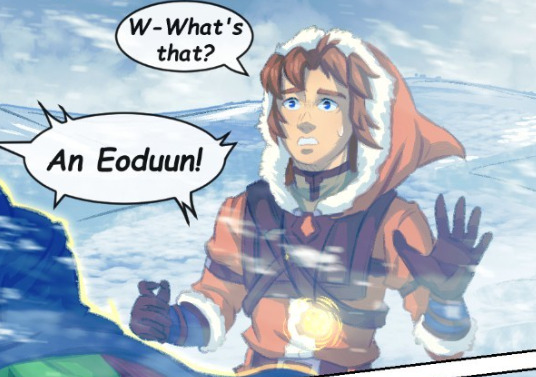
The cinnamon roll needs assistance, is that why he's in orange? Cause he's a little cinnamon roll?
(New headcanon you can't stop me)
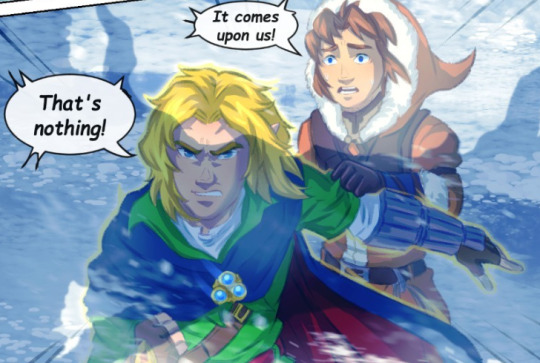
Save him
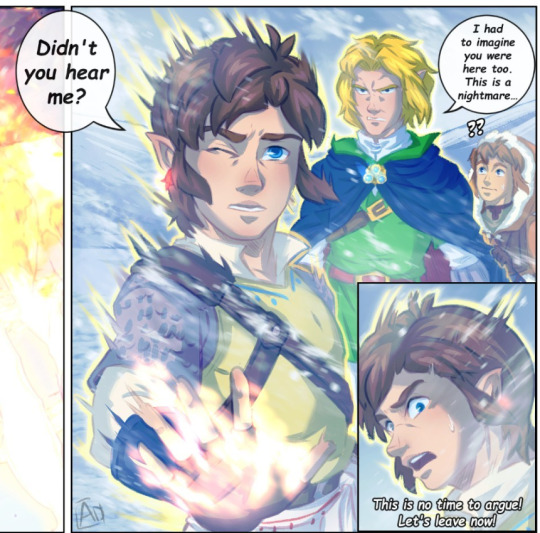
SKYYYYYY
Protective Sky is the best Sky alright
He's so cool!
But the lines I assume are from the spirit barrier from before. Like he's fighting the barrier to be here? Is this gonna hurt Sky to do this? It looks like he's struggling.
I'm going to assume he can't keep this up forever and this is a last resort move.

And Time knowing Sky?! Hello? Makes me wonder if the spirits have been in contact like this.
But I've got a theory about this
I think Time may have not been the only one to aid Twilight. Hence why he knows Sky.
I dont have much to base this on right now but I'm hoping we will see more about this in the next chapter so I can elaborate on this further.
Also look at Link grabbing Time's scarf like he's a toddler, the little question marks are just so adorable and I love this man okay.
Okay, I think thats everything! Thank you so much for hanging out with me as I go through this comic and yell about my faves and the cinnamon roll that is this iteration of link.
And thanks again to the artist for letting me do this!
Hope you have a wonderful day! :D
#comic analysis with major#ramble corner with major#zelda sacred realm#zeldathesacredrealm#sacred realm#sr twilight#loz sr#sr realms#sr time#sr sky#i love this comic#Writing these brings me almost as much joy as Sky does#And that's saying something#because in every iteration dear god does he bring me joy#ztsr#hero of time#hero of sky#hero of realms#sacred realm analysis#:D#hero of twilight#cause we all know thats the boy himself#i am once again rambling at how much i love Sky#cinamon roll link#clearly the orange is to indicate that he is a cinamon roll you cant change my mind on this matter#i dont think there are any tags i forgot#i hope you enjoyed!
30 notes
·
View notes
Text

ESSENTIAL SACRED DHARMA
Compassionate power of the three jewels, Reliable refuge that never deceives, Calming all illusions of meaningless samsara
Bless our minds to turn to the Dharma
Whatever we ponder, the affairs of the world Have no more essence that a sesame seed;
Transform our minds in this short life;
Starting now, reveal the essential sacred dharma.
The time of youth is but a summer flower The luster of beauty but a winter rainbow.
Since human life does not last long
Practice the essential sacred dharma now.
In times of sorrow, we hope for joy.
In times of joy, we fear the coming sorrow.
There is no time free from the straits of hope and fear;
Practice the essential sacred dharma now.
Cherished and protected; base of sickness and disease, Made elegant with ornaments; its nature is impurity.
The impermanent body has no essence.
Practice the essential sacred dharma now.
The rich complain from the place of the rich.
The poor weep from the place of the poor.
Each human mind has its own burden of suffering;
There is no happy time in samsara.
In general, all joys and sorrows that seem outside Are magical creations of one's mind alone;
Reflections from inside that appear outside, Not things outside that have come near.
Knowing this well, when analysis Severs the root of the basic mind, You will abide in the true sky of reality Beyond this fog of appearance.
This so-called existence is a fiction.
This so-called nonexistence is a fiction.
Untainted by all such fictions,
The nature of the mind is perfect buddhahood.
Thoughts of "is" and "is not" are like ripples in water;
They follow one after the other.
Dissolving easily into the aimless state,
They arrive at the ocean of the primordial sphere of reality.
Appearances are the magical display of the mind.
The mind is empty, without base, without foundation.
By holding baseless phenomena to be the self You and I wander in the realm of samsara.
Without pursuing perceptions,
When you look directly at the perceiver itself, You will see your own inexpressible face;
The path to achieve buddhahood is not far.
~ Gendun Chopel
4 notes
·
View notes
Text
An Analysis of Yoga’s Paths to Enlightenment in Hinduism
Yoga, deeply rooted in the ancient spiritual traditions of Hinduism, is a multifaceted and profound practice that offers various paths to enlightenment. It serves as a powerful tool for self-realization and union with the divine. In this article, we embark on an exploration of the diverse paths to enlightenment within the realm of yoga, shedding light on the intricacies and spiritual dimensions of this transformative practice.
1. Bhakti Yoga: The Path of Devotion
Bhakti Yoga is a path centered on devotion and love for the divine. Practitioners of Bhakti Yoga focus on developing a personal and heartfelt connection with a chosen deity or the divine presence. This path involves practices such as prayer, singing devotional songs (kirtan), and acts of service (seva) to express love and surrender to the divine.
2. Karma Yoga: The Yoga of Selfless Action
Karma Yoga is the path of selfless service and action. It emphasizes performing one's duties and responsibilities without attachment to the results. By acting without the desire for personal gain, individuals purify their hearts and minds, ultimately leading to spiritual growth and self-realization.
3. Jnana Yoga: The Path of Knowledge
Jnana Yoga is the path of wisdom and self-inquiry. This path encourages seekers to question the nature of reality and the self. Through contemplation, introspection, and the study of sacred texts, practitioners aim to transcend the limitations of the ego and attain direct knowledge of their true nature.
4. Raja Yoga: The Royal Path of Meditation
Raja Yoga is often referred to as the "royal path" of yoga. This path primarily focuses on meditation and the mastery of the mind. Practitioners work to control their thoughts and emotions, leading to self-realization and union with the divine. The practice of Raja Yoga involves concentration, meditation, and the use of specific breathing techniques (pranayama).
5. Hatha Yoga: The Union of Body and Mind
Hatha Yoga is the path of physical postures (asanas) and breath control (pranayama). While it is often associated with the physical aspects of yoga, Hatha Yoga practice aims to create harmony between the body and mind. The practice of asanas enhances physical health, flexibility, and vitality, while pranayama calms the mind and regulates the breath.
6. Kundalini Yoga: Awakening the Serpent Energy
Kundalini Yoga is a path that seeks to awaken the dormant energy (kundalini) believed to reside at the base of the spine. Through various techniques, including postures, breath control, and meditation, practitioners aim to harness this powerful energy, which is said to ascend through the chakras and lead to spiritual enlightenment.
7. Tantra Yoga: The Union of Opposites
Tantra Yoga is a path that seeks to unite opposites, embracing the duality of existence. This path involves practices that integrate the physical, mental, and spiritual aspects of life. While Tantra is often associated with sacred sexuality, it encompasses a wide range of practices that aim to transcend the limitations of the ego and attain union with the divine.
The Common Thread: Enlightenment and Self-Realization
Despite their distinct approaches, all these paths share a common objective: the realization of the self and union with the divine. The essence of yoga is to transcend the limitations of the ego and to recognize the interconnectedness of all beings. Whether through devotion, selfless service, wisdom, meditation, physical postures, energy awakening, or the embrace of duality, the ultimate goal is enlightenment and self-realization.
Conclusion
Yoga's paths to enlightenment in Hinduism form a rich tapestry of spiritual exploration and self-discovery. Each path offers unique practices and insights, allowing individuals to choose the one that resonates most deeply with their spiritual journey. Ultimately, yoga serves as a profound vehicle for transcending the ego, realizing the divinity within, and attaining a state of profound enlightenment and union with the cosmos. Whether through the heart, the hands, the mind, or the body, yoga opens a transformative path that leads individuals toward the profound realization of their true selves and their interconnectedness with all of creation.
2 notes
·
View notes
Text
And lo, the scientific method did descend upon the realm of knowledge, like a beacon of truth amidst the darkness of ignorance. It did proclaim, "Behold, ye seekers of wisdom, for I shall guide thee in the pursuit of understanding." For the scientific method did teach that observation shall be the foundation, and from it shall arise questions that shall be answered through experimentation. And in the crucible of experimentation, hypotheses shall be tested, and truth shall be revealed. And thus, through the cycle of observation, experimentation, and analysis, the scientific method did bestow upon humanity the gift of knowledge, illuminating the path to enlightenment. So let it be known, that the scientific method is a sacred tool, bestowed upon us to unravel the mysteries of the universe, and to unravel the mysteries within ourselves.
—
4 notes
·
View notes
Text
I watched the new Tears of the Kingdom trailer, and decided to sit back, think about it, read some analysis from others, and try to understand what I saw.
The initial reactions online swung wildly from full hype to disinterest. I probably shouldn’t be too surprised bc I can’t recall a Zelda trailer that has been universally loved. Twilight Princess was close but that was a thing of its time. Zelda games need to be played to understand their brilliance. The true mark of great media.
But I’m not here to analyze people’s reactions. I’m here to talk game.
The Gameplay
Admittedly I wasn’t quite sure about it. I’m not a fan of sky shit bc I am afraid of heights (even in games - makes me anxious as fuck) but with this second trailer and having read comments from folks who watch more gameplay streams and Youtube, my understanding is this game will have more soapbox elements to craft vehicles and whatnot, and that sounds dope as fuck.
Consider the interviews with some of the devs after BOTW released: many discussed the influence of Minecraft, a game that became wildly popular since Skyward Sword released. You can of course point back to many Zelda-like elements in Minecraft, too. This connection between the two series is an excellent example of media influence is a dialogue. I’m very excited to see what elements Tears of the Kingdom brings to it.
Aside from the trailer, if you go to the e-shop, you’ll see the description for the game laying out that this is likely to be more of a sandbox game than maybe any Zelda before it (sorry for the shitty pic lol)

The words “create” and “imagination” really spell it out: this is basically Zelda Minecraft, and I’m here for it.
Link’s Weird Hand/Arm, The Master Sword, and Zelda
I put these all together because I’m not going to say a lot about each, but they’re obviously tied. And Link’s weird arm is related to both the story and game mechanic (he’s using it with powers like the Sheikah Slate gave him).
I can’t guess too much at the story bc I haven’t seen enough. Zelda falls down a hole at point (seeing a lot of “Zelda dies” posts from people who, I assume, don’t understand story or are trolls) and Link and Zelda are separated. Maybe Zelda will be playable, maybe she won’t be. Depends on if it fits into the game mechanics.
Link’s corrupted arm and the decaying Master Sword are connected. I doubt Fi will be returning in any major way like in Skyward Sword, just perhaps callbacks (its too complicated for the story and her use as a guide isn’t needed). However, something (or better yet, SOMEONE) is deliberately trying to destroy the Master Sword. Of course they are: the Master Sword has the ability to repel AND lock away evil. Ganondorf himself in Wind Waker describes it as a key, and every time we have seem him he is killed or held in place by its power (in OOT, Link holds him with it so the sages can toss him away into the Sacred Realm, in Wind Waker it turns him to stone, and in Twilight Princess it kills him). We haven’t seen Ganondorf since Twilight Princess. Presumably by BOTW he’s figured out the sword needs to go. And that’s what is happening: the key to hold back Ganondorf is being destroyed.
As for Link’s arm, its facing similar decay. But its not being destroyed. It’s just withering to look corpse-like (and look like a certain Gerudo king whose corpse we also see - more on him in a sec). But why Link? Maybe its a way to destroy him, too.
I had this thought about how, if Breath of the Wild was revisiting the original Zelda, then what if Tears of the Kingdom is revisiting Zelda II? And if that is true, one major plot point in that game is that monsters are hunting Link because if they kill him and spread his blood on Ganon’s ashes, they will revive him (if you die in the game it tells you Ganon returns, ominously lol). So what if that’s how Ganondorf is trying to revive?
The only thing is that it doesn’t quite fit with Zelda’s words in the trailer, but its just a theory so I’m excited to be wrong, too.
Return of Ganondorf(???)
One of the bigger story reveals of the trailers has been the Ganondorf-like corpse hanging around (in some cases literally).
First off, is it Ganondorf? We assume yes because all evidence points to it. Probably the best argument is that he wears a Gerudo emblem, and he presents as male. Male Gerudo being extremely rare and, in BOTW, non-existent (presumably due to Ganondorf acquiring the Triforce of Power and living forever), it is unlikely to be any other Gerudo male but him.
But is HE running the show? The voice over in this trailer was, for me, something I was actually hoping for, and I was shocked I got it. But it makes sense: Ganondorf is the last major Zelda character who had no voice. He’s a fan fave, the devs like him. He feels like the missing piece.
I’ve seen theories that the voice was Demise but that doesn’t work: Ganondorf is Demise reborn like Zelda is Hylia. So they’re the same person. I think we’re so used to being tricked and hoodwinked by modern media that when we are presented now with the most obvious answer we hesitate to believe it. But its likely Ganondorf.
But what is he doing? Reviving? Or is his power being used by someone else? An interesting scenario would be if Zelda, Link, and Ganondorf are forced to work together for a common interest. There’s also the possibility that Ganondorf is tricks them into freeing him from something else.
However, i really think there’s a point where Ganondorf is pulling the strings bc his speech points to the huge grudge he has against the Kingdom of Hyrule, the destruction of the Master Sword he sees as gatekeeping his powers, and the destruction of Link, the hero who keeps thwarting him.
He could also be trying to get Link to switch places with him in a kind of limbo-hell. What if thats the corruption away Link’s body? a reverse curse where Link is drained and goes to whatever purgatory Ganondorf is stuck in?
That’s all I have for now. I’m sure more will come in time. And all will be revealed this May!
#spoilers#zelda#tears of the kingdom#totk#totk spoilers#tears of the kingdom spoilers#zelda spoilers
16 notes
·
View notes